#couture ornaments
Explore tagged Tumblr posts
Text


Dolce & Gabbana - Alta Moda Autumn-Winter 2017 Couture in Palermo
#dianthus#carnation#flower pattern#flower ornament#embroidery#haute couture#dolce & gabbana#2010s fashion
3 notes
·
View notes
Text
Accessorize yourself with Ornaments.
What are ornaments?
Hello everyone, I hope you all are flourishing. So, you won’t believe what is coming up in this article of accessorize yourself with Ornaments and Apparels. Well, we all dressed up as per our own comfort after looking for the trends. Yes, trends are most important as per today’s life. Ornaments are like some objects which beautify your outfits. These can be made up of different metals and it depends upon the person what he or she wants to wear along with which dress. In ancient times, people used the stones and after carving it they produced the final object to carry with their dress to look different from others. As the time flew, the natural things were used as ornaments like Flowers, Petals, Pebbles, Threads, Crystals and Stones Feathers. These accessories were worn on the special day or sometimes famous people or leaders used to wear. Nowadays, you can accessorize yourself with ornaments to look different and to beautify their outfits.

A spice to your dress.
Ornaments are like icing on the cake. It embraces your uniqueness. While carrying a simple necklace on a gown makes you present better rather than staying simple. A piece of metal can elevate your appearance and it can enhance your confidence. It makes a dress beautiful. The collection of the right piece of metal can represent your wealth, status, your power, etc. Men also Accessorize themselves with ornaments to show their dignity. Some of the ornaments are worn to preserve tradition. Accessorize yourself with Ornaments as they are like a pinch of salt which makes the dish perfect. You should check the color combination of dress and footwear as well as which will greatly help you to dress up well.

Truths and Myths…
The trends of the ornaments are processed from our ancestors. According to Indian rituals the married women should carry rings in their toes which helps them to stay healthy and it is worn on the 2nd toe of the foot. It is also a myth that this brings good luck to a married couple and provides longevity to a marriage. As specified by some people the toe ring should be built with silver metal only, which will surely help the ladies to get the benefits from it. The main and traditional stone of Australia is Opal, Jadeite is stone for Japan, Taihu (Tai Lake) stone is found in China. These things can be true and fake as well but this whole context is written as per my myths and truth spread all over the world.

Ornaments in fashion.
To accessorize yourself with ornaments, we are always eager to choose a piece of metal which beautifies our dress. Moreover, people are choosy to select the accessories according to their closets. Specially male choose simple and aesthetic objects like wrist watches, rings, hats and caps, a chain for neck, cufflinks, tie accents, blazer buttons, shirt studs, lapel pins, belt buckles, earrings, and money clips, etc. Men always prefer to buy branded accessories. There is a fashionable trend of belts and scarves, gloves among women. Fashion is done as per the current tendency. Fashion ornaments should be chosen as per the age of a person. And please try to do not over fashion in a state of accessorizing yourself with ornaments. Preserving your own traditional ornaments makes you feel proud and you would be able to share the details with your descendants.

Which ornaments should be opted?
I am aware that you are perfectionist for choosing the objects for yourself, but there should be change in your trend as fashion is rapidly changing. For example :- boys used to carry printed ties with plain Shirts and blazer suits, but nowadays the trend is for plain ties along with shirts, especially white and black ties. Moreover, in casual dresses there is a trend of carrying a half sleeves shirt with shorts. There is a trend of one foot anklets for women. These should be getting matched with your costumes. Different accessories from your dress will let you down in public.
Ornaments for gifts…
We all have lots of friends, and we celebrate their birthdays and their special occasions with them and we give them some presents in the form of happiness. In today's life it is quite difficult to give gifts to someone, but we know the common preferences of a male and female so, in the same accordance we purchase some things and give gifts to someone. Ornaments are the best gifts ever to give someone. As women have a wide range of ornaments and people have a lot of options to give gifts to their loved ones. Girls can give gifts as bracelets, necklaces, earrings, etc.

Self esteem…
As it is clearly understandable that ornaments help a person to be fulfilled with confidence. The individuals get self pumped after accessorizing themselves with ornaments. It is necessary which ornament you are wearing with which dress. Both things should justify each other. For instance, do not wear bangles or hand bands along with wrist watches. Do not wear anklets along with jeans tops otherwise it will let you down in public. As in ancient times, a king used to carry a lot of gold and specially a crown on their head to accessorize himself with ornaments. And in the current era, people use to buy branded things to show their prestige and it also seems rich rather than others.

Choose right.
So, have you set a plan for what you are going to purchase? Have you decided what gift you are going to give someone? Have you done with your mind mapping which dress suits well with an accurate dress? If you are facing an obstacle then we are a right place to ask about your query. Accessorize yourself with ornaments with the right collection.

In conclusion, there are several influencers all over the world, and if you really want to get change and want to flow with fashion then you should take counseling from influencers as ornaments embraces your dresses, styles, your elegancy, your self esteem, helps to preserve your traditions, groom your rituals, your looks, etc. and accessorize yourself with ornaments.
#ancient history#ancient greek mythology#archaeology#ornaments#accessories#fashion trends#viral trends#market trends#jwellery#old jewelry#menswear#haute couture#chic#fashion designer#fashion#style#couture#runway#fabric#film#trending#artists on tumblr#tumblr girls#photographers on tumblr#writers on tumblr#instagram#streetwear#street style#street art#photography
0 notes
Photo
Matadit Jewel Suit, Christian Dior Haute Couture, Autumn/Winter 1997
Model: Constance Jablonski
Photographer: Patrick Demarchelier

1997 John Galliano for Christian Dior, Haute couture
#dior 1997#christian dior#john galliano#haute couture#galliano 1997#exquisite ornamentation#fashion photography#90s haute couture#patrick demarchelier#constance jablonski#matadit jewel suit
57 notes
·
View notes
Text
Writing Notes: Fashion History

for your next poem/story (pt. 1/2)
1850-1879
The Civil War began in 1861 and ended in 1865, heavily impacting the lives of those living during the time period. In fashion, the rise of the sewing machine allowed more decorative effects to be used in dress, and new aniline dyes paved the way for brighter shades of dress.
This time is known as the Crinoline Period because cage crinoline made of whalebone or steel hoops replaced heavy layers of petticoats, and were commonly worn under dresses by women of the time.
One trend that hit its peak in the 1870s was the bustle, an item women secured under the back portion of their skirts to add volume.
In terms of silhouette, a narrow waist with a fitted bodice and full skirts was the recurrent style. Popular sleeve styles included pagoda sleeves, gathered bishop sleeves, and the coat sleeve.
During the day, high necklines were appropriate, but women often wore lower necklines in the evening.
Wraps and shawls were commonly worn, and accessories such as parasols, gloves, snoods, and bonnets were highly desired.
1870-1900
The years 1870-1900 include what is known as the Bustle period, in which the popular silhouette shifted from full skirts to a more fitted look characterized by fullness in the back.
Throughout the Bustle period of the 1870s and 1880s, a variety of padded devices were utilized to create back fullness, as the bustle took on different forms.
The bustle of the first stage (1870-1878) was achieved through manipulation of drapery and the use of decorative details such as flounces and bows at the back.
From (1878-1883) fullness dropped to below the hips and decorative effects of the skirt became focused low as a result.
Long trains and heavy fabrics also helped to emphasize the focus on the rear.
The latter part of the decade (1884-1890) saw the bustle at its largest. Often referred to as the shelf bustle, it was rigid and took on the appearance of an almost horizontal projection. At this time, skirts shortened to several inches above the floor and rarely had trains, with the exception of some evening dresses.
Additionally, they include the 1890's, which are often referred to as the Gay Nineties or La Belle Epoque. Times were good, Paris was the center of high fashion, and for those who could afford it, dress was lavish and highly decorative.
The corset continued to be worn, aligning with the fashionable silhouette of a full bust and hips with a narrow waist.
Dress ensembles typically consisted of two pieces -- a bodice and matching skirt.
The one-piece princess dress, worn by some during the latter part of the period, was an exception. Bodices were often fitted, with the cuirass bodice style emerging from around 1878-1883.
Sleeves were close-fitting and ended at either three quarters or at the wrist.
Evening dresses were differentiated by their lavish trimmings, level of ornamentation, trained skirts, and short sleeves. Weighted silk offered greater body and was a popular choice for dresses beginning in the 1870s.
Full sleeves were at their largest in 1895, before they gradually decreased in size towards the turn of the century.
By the 1890s, sleeve with fullness were only seen with small puffs at the shoulders.
Tailor-made costumes consisted of wool or serge skirts worn with a shirtwaist blouse. and were considered ideal for traveling.
Shirtwaist blouses were often accessorized by cravats and jabots. The variety of outerwear for women increased during the late nineteenth century and was dominated by coats, jackets, and wraps.
Accessories of the period included small hats, gloves, muffs, decorative fans, and parasols.
1900s
The first decade of the twentieth century is often referred to as “La Belle Époque” - French for "the beautiful age." During this time, Paris reigned as the capital of art and fashion, extravagance and opulence was in, and French couture became all the rage.
Edward VII became King of England with the death of Queen Victoria in 1901, ushering in the “Edwardian Era.”
Additionally, Henry Ford's Model-T was introduced in 1908.
Art Nouveau influenced fashion and ornamentation with the popularity of curvy shapes, floral prints, and ornamentation.
And with the introduction of Ford's Model-T, "motoring garments", such as duster coats and goggles, became essential for automobile riding.
The dominant silhouette of the period was the S-bend hourglass shape, which was achieved through the use of long bell or trumpet skirts that swept the ground, and the “monobosom” fullness of the front bodice.
Voluminous sleeves were another popular feature of turn-of-the-century fashion. Women still wore tightly-boned corsets, along with layers of petticoats. Two-piece ensembles were introduced, consisting of a skirt and a shirtwaist blouse. Garments often featured necklines with high standing collars for daytime and exceptionally low décolleté necklines for evening wear.
Lingerie dresses — flowing white gowns with lace detailing — were a popular choice for outdoor hot weather. Pale colors and un-patterned fabrics adorned with lace or embroidery were favored in this style. Shoes and boots exhibited pointed toes, and parasols were a must-have accessory for outdoors. Elaborate, often large hats decorated with bird feathers enjoyed heightened popularity.
1910s
The War Years (1914-1918) resulted in simpler styles, with moderation in fabric usage as well as the use of darker hues. As a result, garments of this period often have a more utilitarian and masculine appearence.
The “teens,” as the 1910s are often referred to, saw sweeping changes in fashion due to the work of French designer Paul Poiret, who was largely inspired by both the exoticism and color of the Far East and the Ballet Russes. “Orientalism” in fashion became all the rage and was seen in kimono-shaped coats, capes, saturated colors, and exotic embellishments.
Popular trends included the “peg-top” silhouette with hip fullness, Paul Poiret’s narrow-at-ankle “hobble skirt”, and Mariano Fortuny’s “Delphos gown” which featured his secret pleating technique.
Tunic dresses were also introduced, and featured a short skirt layered over a longer one. Necessitated by the new shapes in fashion, the hourglass S-bend silhouette transitioned into a more column-like, tubular form with a higher waistline. Brassieres replaced tight corsets and accommodated the soft, unfitted tea gown, a popular choice for afternoon hosting. The wide-brim hat continued to be a fashionable accessory and shoes began to replace boots.
1920s
The year 1920 marked the beginning of Prohibition, as well as the end of the Suffrage Movement, with women gaining the right to vote.
King Tutankhamen’s tomb was discovered in 1922, further fueling the taste for the exotic, and creating an obsession with all things Egyptian.
The Harlem Renaissance ushered in the Jazz Age; sleeveless dresses with shorter hemlines and sequin, bead, and fringe embellishment enhanced and enabled the fast-paced dance movements of the Charleston and Fox Trot.
The "Roaring Twenties" were years of major change for both fashion and society.
Besides major cultural events inspiring change, fashion was also influenced by Art Deco through the use of straight lines and geometric forms in both silhouette and decoration. The twenties silhouette was straight and tubular, and dresses deemphasized female curves, breasts, and hips.
Chemise dresses hung straight from the body and helped created this fashionable linear silhouette. The “flapper,” with her bobbed-hair and boyish silhouette, became the epitome of the fashionable look of the period. Hemlines rose, revealing more of the female leg for the first time in dress history, and shifting the focus to shoes for the first time.
During the period, Gabrielle “Coco” Chanel popularized costume jewelry — as well as wool jersey suits.
The cloche, a bell-shaped hat, was “the” hat to have.
Small beaded purses and long beaded necklaces were popular accessories.
1930s
The defining event of the 1930s was the Great Depression.
The stock market crash of 1929 and the ensuing depression created a need for less expensive garments without elaborate ornamentation. Designers of the period therefore relied on seam lines and darts as major forms of embellishment. Clothing that was cheaper and diversified was critical, thus creating the need for ready-to-wear fashion.
The overwhelming popularity of the movies in the 1930s helped perpetuate the ideals of “Hollywood glamour.” Women began looking to screen stars for inspiration in fashion, hairstyles, makeup, and even demeanor. The movies, and the glamorous lifestyle they portrayed, were a way for the public to escape the harsh realities of the Depression.
Designers such as Elsa Schiaparelli incorporated concepts of Surrealist Art into fashion designs, offering fantastical creations that also provided a flight from reality.
The 1930s also saw the birth of American sportswear and two-piece bathing suits for women. The decade saw a continuation of the linear shape of the 1920s, but with a leaner, longer, more feminine silhouette. The waistline returned to its natural position and hemlines dropped. Evening fabrics tended to be pale or white solids of silk or satin, and the backless evening gown was introduced at this time.
French designer Madeleine Vionnet created the “Bias Cut”, which produced a “liquid” clinging effect on the body. Hats of all varieties were widely worn, and a right-angle tilt was a common way hats were styled. Shoes featured low heels and rounded toes. Costume jewelry and fur added the final touch of fashionable glamor.
1940s
World War II began in 1939, ushering in a new conservatism in fashion. Fashion designers were forced to close their houses in Paris, and “practicality” became the new buzzword in fashion, with a focus on producing sensible styles and “utility garments” which required a minimum quantity of fabric.
In the United States, the L-85 Limiting Order aimed to freeze the war-time silhouette and stop rapid seasonal changes in styles in order to conserve fabric use. Tailored suits and military-influenced styles were seen in items such as belts, breast pockets, high necklines, and small collars. Both clothing and hair were influenced by the war.
For women who worked in factories, superfluous decoration and long hair posed safety threats. Hairstyles and makeup became an integral way to achieve personal style, since clothing and accessories were rationed.
Hollywood stars such as Veronica Lake, Rita Hayworth, and Bette Davis were significant influencers of fashion. American designers began developing sportswear collections, spurred by the necessity of the war-time focus on the ideals of simplicity and utility.
Casual separates, shirtwaist dresses, slim skirts with patch pockets, and halter and square necklines became popular. Women could also be seen wearing trousers, although it was mainly for utilitarian purposes, not everyday wear.
The 1940s silhouette was tailored and narrow, with a nipped-in waistline and squared shoulders achieved through the use of shoulder pads. Hemlines rose to just below the knee. In light of rationed fashion, hats allowed an individual fashion statement, and small styles such as veiled pillboxes and berets, often worn at a right angle, were most popular. Shoes were usually chunky with rounded toes and featured either low-heeled or wedge soles.
Leg makeup was also introduced and offered women a remedy to the rationing of nylon stockings.
More Notes: On Fashion ⚜ Writing Notes & References
#writing notes#fashion history#writeblr#worldbuilding#spilled ink#dark academia#writing reference#fashion#literature#writers on tumblr#writing prompt#poetry#poets on tumblr#creative writing#writing inspo#writing inspiration#writing ideas#fiction#writing resources
154 notes
·
View notes
Photo

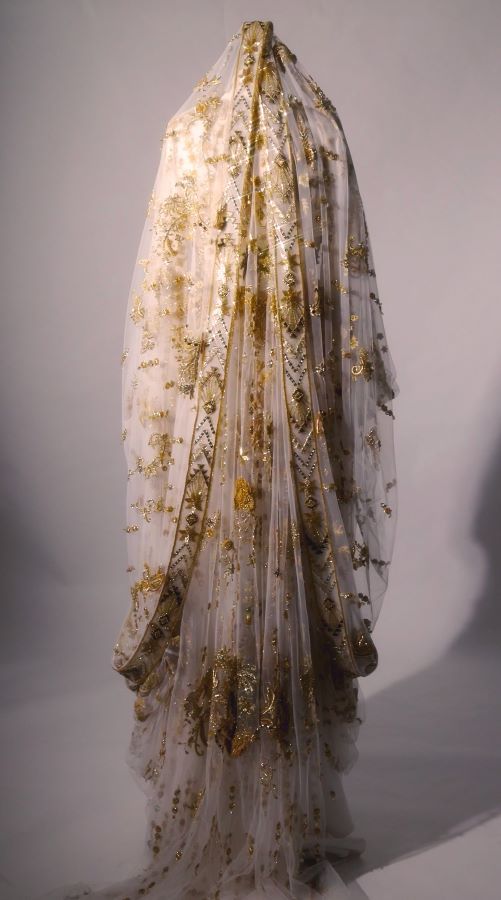
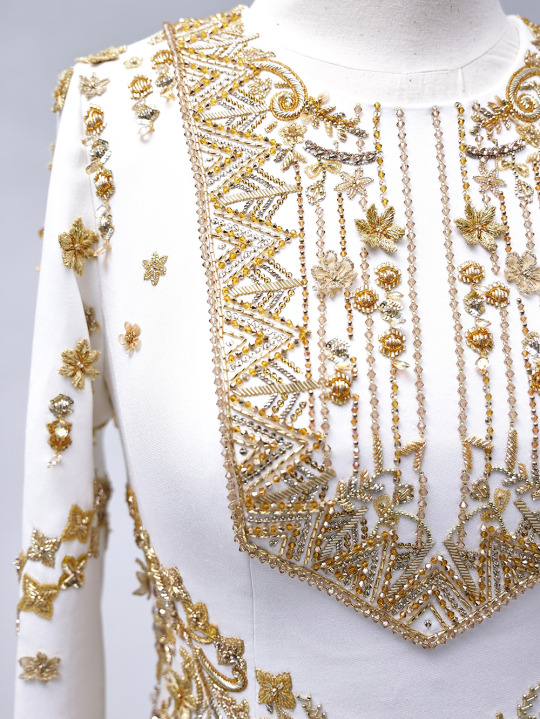
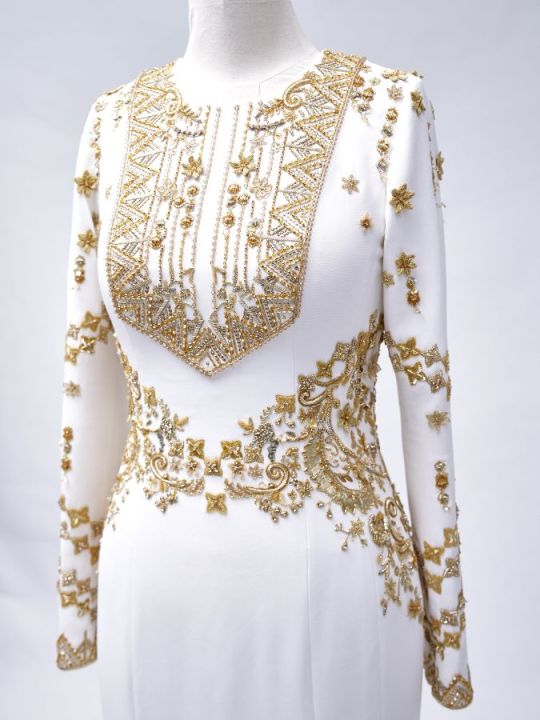
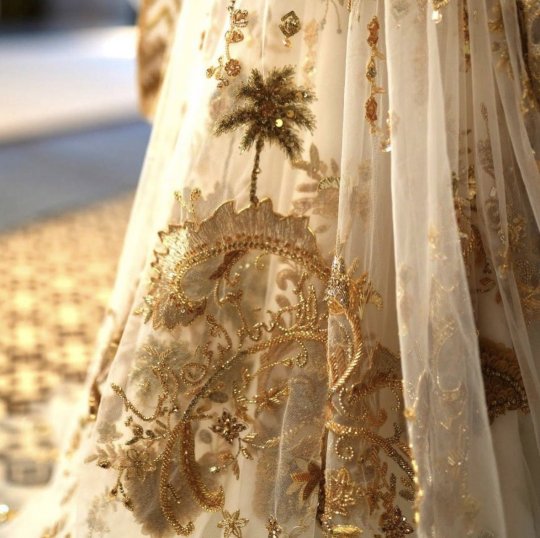

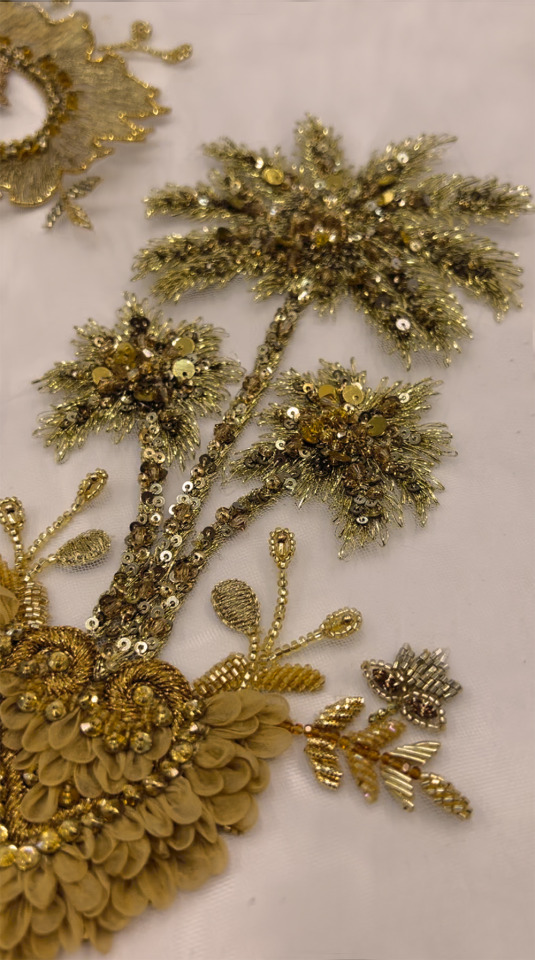

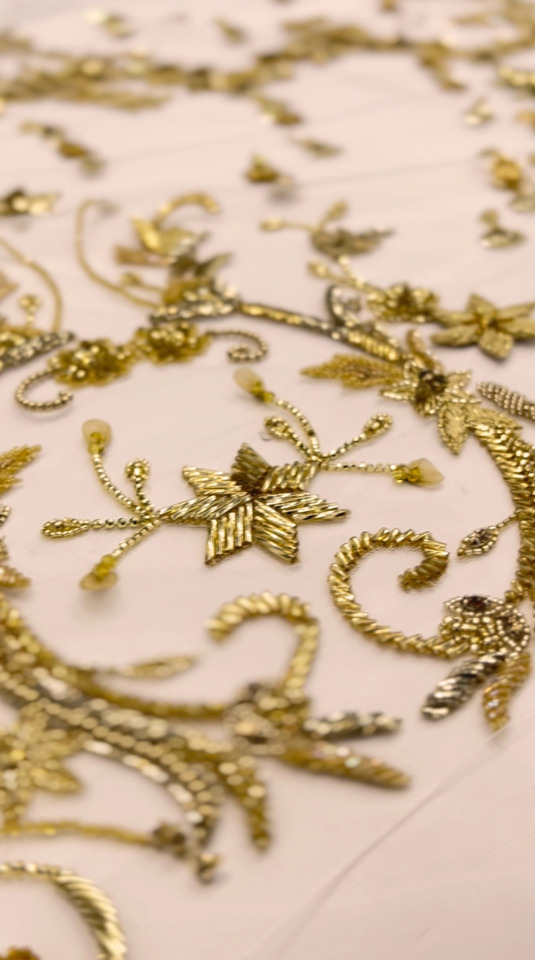
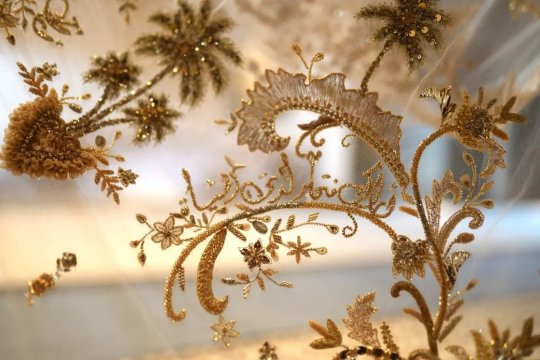
Close-up of Rajwa Al Saif's henna party outfit on 22 May 2023. The dress, by Saudi designer Honayda Serafi, took more than 2,000 hours to create, and includes several hidden messages of love, Vogue Arabia reports.
“Crafted by Saudi designer Honayda Serafi, Al-Saif’s henna dress is a vision in white and gold. The future queen of Jordan celebrated with family and friends in a look that takes inspiration from the traditional Najdi dress, known as Sahabi thoub, which originates from the Najd region of the Kingdom of Saudi Arabia. Keeping in mind the occasion and the family, Serafi made sure to combine the cultural beauty of the Hashemite kingdom of Jordan and the Kingdom of Saudi Arabia to celebrate the union of Rajwa and Prince Hussein beautifully.
Featuring a handcrafted veil and dress, Rajwa Al-Saif’s pristine white henna outfit comes doused in 3D ornaments, made using a mix of silk, metallic threads and traditional reed strings (a signature element of Najdi embroidery). To create this masterpiece, Honayda Serafi took cues from the bride’s personality, attempting to reflect her innate grace, the rich traditions of her land, and her contemporary spirit.
Look closely, and you’ll notice that Al-Saif’s gown is replete with lovingly made details. Featuring a high round neck and full sleeves, the crepe gown features an inverted triangle-shaped bodice that is inspired by the traditional Najdi bodice design, normally worn as a separate piece. As the body-skimming gown continues, it flares out towards the ankles to create a mermaid-esque shape. The bodice of the gown is elevated using embroidery: soft organza flowers share space with geometric shapes and Arabic motifs, all of which are typical to Saudi Arabia and reflect the beauty and traditions of the bride’s homeland.
Rajwa Al-Saif’s veil has also been embroidered with meaningful designs, making this piece so personal to her journey. Seven Jordanian stars adorn her veil to signify the seven-pointed star that sits proudly on the Jordanian flag. What makes this symbol even more special is its religious meaning: The star on the Jordan flag signifies the seven verses in the opening chapter of the Holy Qur’an, and the seven mountains of Amman.
Along with the stars, the veil also features intricate palm trees as a reference to Saudi Arabia, and even some poetry. The words “I see you, and life becomes more beautiful” have been embroidered into Al-Saif’s veil, from Tunisian poet Abu al-Qasim al-Shabi, known for his Andalusian notes. If you’re a fan of Rajwa Al-Saif’s elegant wardrobe, you may already know that the bride-to-be has a soft spot for special symbols when it comes to her clothing. Back in August 2022, when Rajwa was officially engaged to Prince Hussein, she also commemorated the occasion with her clothing—an abaya that was embroidered with two gold birds, symbolizing two souls in love.”
The veil took 760 hours to complete
An exquisite piece of couture requires hours of effort, and Rajwa Al-Saif’s henna outfit is no different. According to the designer, Al-Saif’s veil took 760 hours to complete, and was worked on by a team of experts, craftsman and women. Extending to 10 meters, the piece was made using handcrafted tulle, a process that normally takes close to 2,000 hours of work. As for her billowing gown, the creation is the result of 340 hours of work.
Honayda Serafi: “I am very proud and honored to be part of this historic union”
Speaking on the occasion, Serafi shared, “I am very proud and honored to be part of this historic union between His Royal Highness, Crown Prince Al Hussein bin Abdullah II of the honorable Hashemite family, and Miss Rajwa Khalid Alseif. May they be blessed with happiness and their union be crowned with success.” (x)
808 notes
·
View notes
Text
WW I Part II
Women's fashion has less ornament and detail. Pockets were stictched on the exterior of women's skirts and jackets instead of hidden in seams. Jackets were worn longer over the hips and looser fitting with belts wrapped around the waist. Women's waists were no longer emphasized as they had been with corsetted dress. Women's skirts were shorter and showed their shoes.

Suits by Chanel in silk and wool jersey.
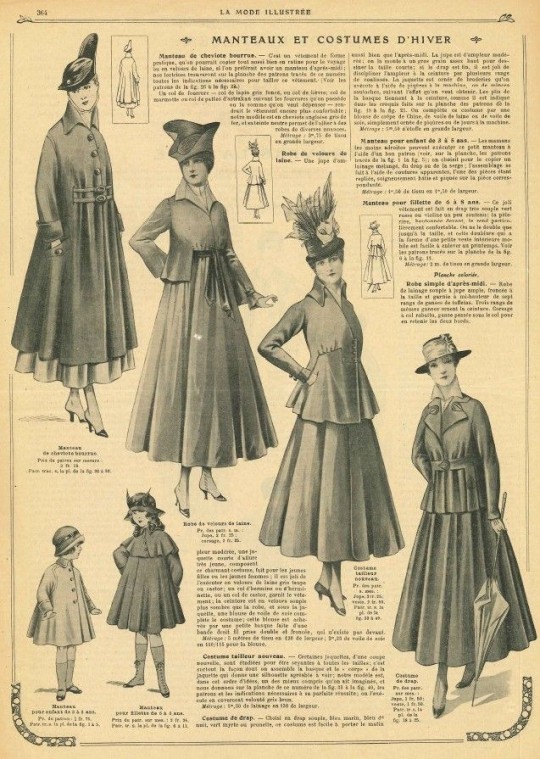
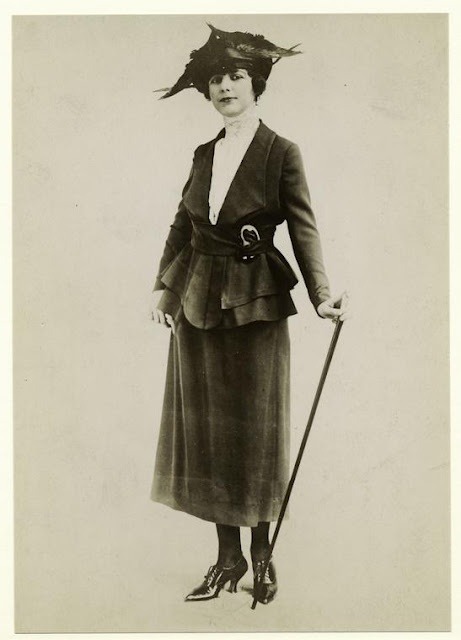
La Mode Illustrée, October 8, 1916 | Woman's suit • 1918
Though we don't think of haute couture and war as having anything in common, in France the manufacturing and export of fashionable clothing for women helped to keep the economy going during World War I.

Fashion Plate for the French magazine Les Elegances Parisienne • 1916

While Coco Chanel got her start during the great war, it was Paul Poiret who was the star of the era's high fashion. Referred to as the King of Fashion in America in the 1910s, Poiret is most famous for his designs influenced by Orientalism, Neoclassicism, and Surrealism; the kimono, the Turkish trouser, the slit skirt, and the famous lampshade dress. Mostly, he is remembered for his stance on women’s fashon and the simplification of the female silhouette. He dismissed the petticoat and the corset, as the trends shifted away from tailoring toward draping. He disliked the word fashion, opting instead to design women’s clothing solely as an expression of individuality. “Women are wrong for following one style,” he said.

Paul Poiret's "lampshade" fashions


Chanel photos. The one on the right was taken in front of her first boutique in 1914.
#fashion history#women's fashion history#ww 1 fashion#chanel#paul poiret#the resplendent outfit fashion/art blog#vintage fashion photos#the lampshade dress#1910s fashion catalog#1910s fashion plates
45 notes
·
View notes
Text

Le Petit écho de la mode, no. 9, 1 mars 1896, Paris. 8. (1) Costume en drap amazone pain brûlé. (2) Costume en mohair glacé cama��eu. Ville de Paris / Bibliothèque Forney
(1) Costume en drap amazone pain brûlé. — Jupe â godets. Veste fantaisie â revers carrés. Chemisette-corsage en tissu pareil plissé. Manches d’une seule pièce. Ornements de piqûres et boutons métal.
(1) Suit in burnt bread amazon cloth. — Godet skirt. Fancy jacket with square lapels. Corsage blouse in similar pleated fabric. One-piece sleeves. Stitching ornaments and metal buttons.
Matériaux: 8 métrés tissu.
(2) Costume en mohair glacé camaïeu. — Jupe nouvelle, â 8 lés. Corsage ajusté garni d’un double pli creux et de pattes assujetties par des boutons. Ceinture ronde et col droit. Manches d’une seule couture.
(2) Suit in monochrome glossy mohair. — New skirt, 8 lengths. Fitted bodice trimmed with a double box pleat and tabs secured with buttons. Round belt and straight collar. Single-stitched sleeves.
Matériaux: 8 mètres tissu.
Employer la Fibre chamois pour les jupes et corsages.
#Le Petit écho de la mode#19th century#1890s#1896#on this day#March 1#periodical#fashion#fashion plate#description#Forney#dress#gigot#suit#collar
112 notes
·
View notes
Text
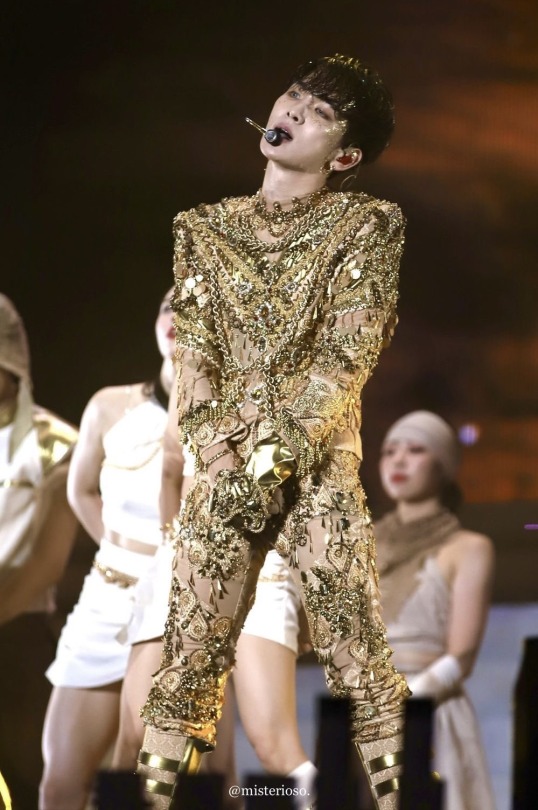
Isn't it glorious?
It’s here! I finally tackled my analysis of Key’s gold Gasoline era costume, worn in his music video for the song, photoshoots, a stage performance at the Inkigayo show, and a live performance at SM Town 2022. I’ll discuss everything from the fabrics used, the gloves, the shoes, complain about the zipper, talk about whatever the heck jumps are, break down all of the tiny little types of ornamentation (including the things I don’t actually know the name for) and more.
It’s scary in the best way. Buckle up. Grab some coffee or tea or vodka and a blanket.
I want to preface this by saying that this is going to be VERY long. I’ve polled my followers and nearly everyone said they want me to get as granular as I want. So I’m doing that. If that’s not your thing, here’s your exit ramp now. I get it. This is absurd.
You can also read it on my Twitter here. It actually has a LOT of bonus photos because they only allow me to have 30 on here, if you’re interested in seeing more. It may help clarify some things, as well.
Now then. Welcome to those who are left. Let’s begin!
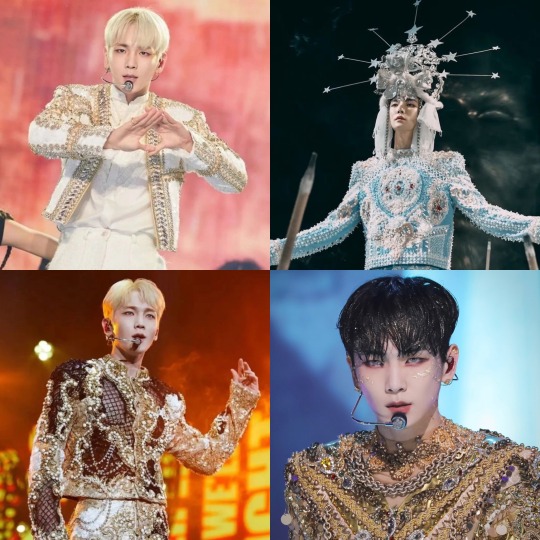
Costumes by Dénicheur by Seo Seung Yeon
For his Gasoline era, Key has had four costumes designed and made by Dénicheur by Seo Seung Yeon, a Haute Couture Designer House that, among other things, makes elaborate costumes for Kpop performers. They’ve got an amazing Instagram portfolio to check out. They made him a gold and black costume for his G.O.A.T in the Keyland concert, the blue and white one for the Gasoline MV, this gold one, and a cream and gold beaded jacket for the 2023 SM Town Concert.
This fashion house’s trademark is intricately beaded, appliquéd…encrusted…costumes. I was able to get some high quality photos from some of you (thanks so much!) And the more I looked, the more I discovered.
If this were a piece of art (well, it is, but not in the same way) “Mixed Media” is what I’d call it. There are literally over twenty different types of beading techniques, appliqués, various types of sequins, trims, braids, rhinestones, chains, and more.

First, I’ll do an overview of the garments themselves, and then I’ll move on to the ornamentation.
The top (it’s not a jacket, it’s not really a shirt, it’s not a tunic. So I’m going with “top”) has a very boxy torso with exaggerated wide, padded shoulders. They’re completely squared. There are straight sleeves—not too slim, not too bulky. There’s a heavily ornamented oversleeve that reaches down to about his elbows and a “nude” colored full length under sleeve. It also has heavily ornamented cuffs at the bottom the sleeve. It has an exposed zipper up the center back that goes up into a short turtleneck collar. The collar and a portion of the lower neck back region are sheer with some beading and appliqués. There are sheer spirals around his arms and in chevrons on his front and scooping around to his back.
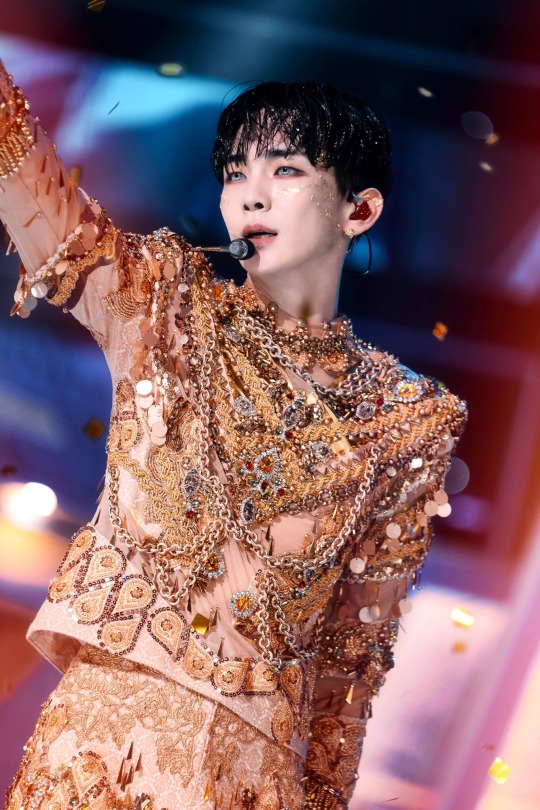
Just LOOK AT that masterpiece
The trousers are closely cut through the waist, hips, and thighs but become a bit wider at the knee. It looks like they were made full length but are always worn bunched up over knee high boots. They close at the center front with a very beautifully set fly zipper and flat trouser hook and bar. It’s so low profile that it wasn’t until I got some 4K images that I was even sure of where they closed. It was like he had been sewn in. I wrote a whole thread about it on Twitter that reads like a mystery novel, though I already spoiled the ending for you. Sorry.
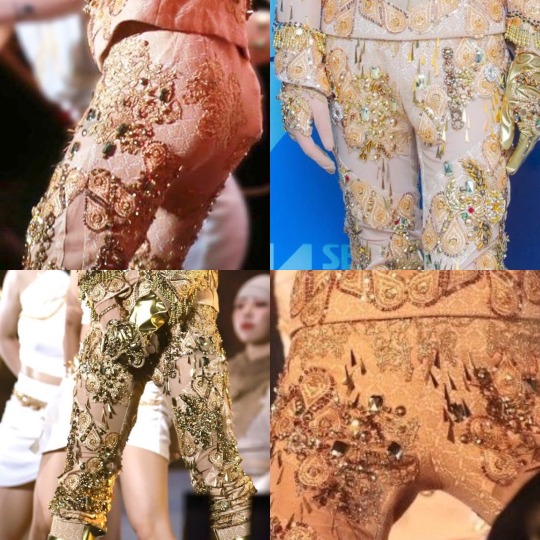
The top is made of what is probably a “nude” (aka specially dyed to his skin tone) base fabric to hold the structure, with the ornamentation stitched over top. The external stabilizing fabric is what appears to be some sort of jacquard, possibly silk.
Jacquard is a type of weave, where the fabric is made of long and short “up and down” stitches of sorts, to make a pattern. Because some of the time it uses longer “stitches” on top, it becomes more vulnerable to the fiber breaking and makes it become kind of “fuzzy” looking. This can be especially true if it’s a natural fiber that usually has less structural integrity than a synthetic one. I initially thought this had started to happen on Key’s rear, but after a very close zoom in, I think that’s just a bit of appliqué edge pulling up. I think maybe one of his mic packs is down there too, but I’m really not an expert in that. I did the research so you don’t have to, folks.
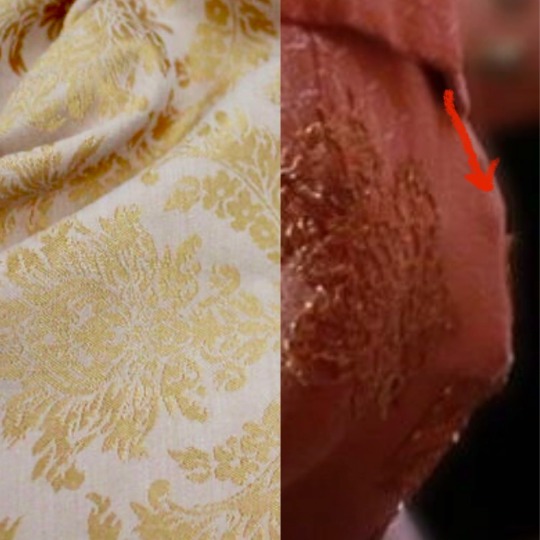
Left: A type of jacquard fabric. The shine comes from the longer top threads, contrasting with details of shorter threads. Right: Is it an applique or is it some snagged fibers? Ultimately, I think it's an applique edge.
Perhaps the most interestingly nerdy thing about jacquard is that it was originally made on a loom that led to the creation of computer programming by utilizing a sort of “binary code.” There were punchcards that showed the strands of fibers when to go up and down. Like “holes and not holes” in which to weave.
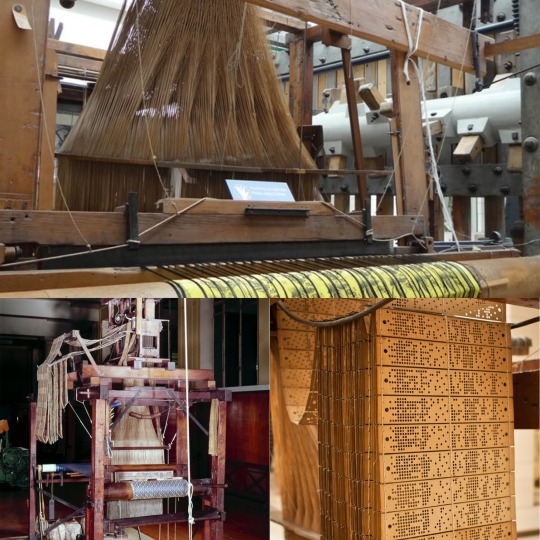
A Jacquard Machine Loom with punchcards that create the desired design on the fabric
It’s important to note that this fabric needs to have some stretch because it is also used to make his very tight fitting trousers. If it were not a stretch fabric, he wouldn’t be able to do this like THIS or…most things, really.
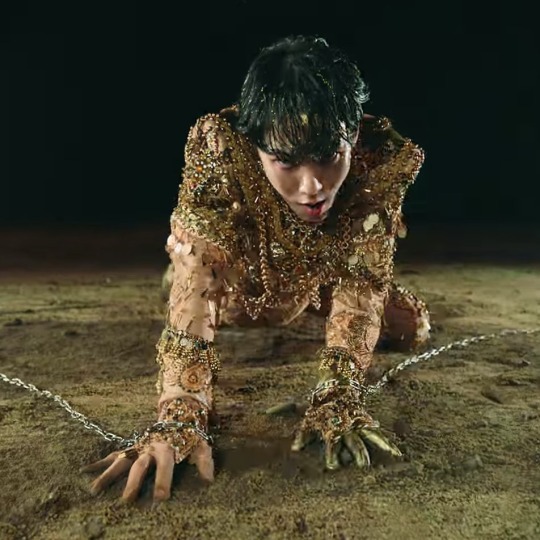
Even though the jacquard is stretchy, it has some structure to it. It’s used as a stabilizer in between the “flesh mesh” on the outer layer. (aka power net, stretch mesh... There are many names!) It forms the base on which the majority of the ornamentation is stitched.
Flesh mesh is a stretchy mesh fabric dyed to the performer’s skin color and is used to give the illusion that you’re seeing their skin, but it gives much more strength than just a cutout. I wrote a thread about flesh mesh and the importance of taking into consideration the performer’s actual skin tone when building them a costume here
In this case, flesh mesh allows for adornment of these areas, as well. It’s important to note that, even though it’s a separate layer over the base, it is “tacked” through all layers in a regular fashion so it doesn’t droop with the weight of all of the ornamentation.
There are also some parts that have metallic gold applied pieces. This was probably made of a beefy metallic spandex applied on top of the base rather than some solid pleather, due to way it behaves on the body. The latter would have been way too rigid in comparison to the rest of the fabrics.
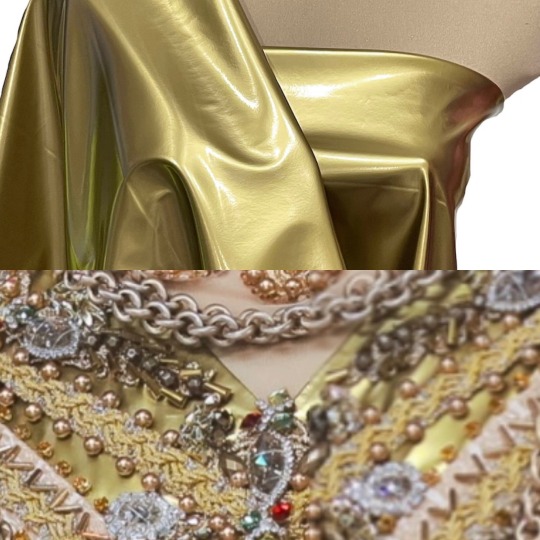
Heavy gold stretch spandex, forming a chevron on which to affix beads and other trims
Okay. Range of movement time. You know how I love discussing this. That’s because it’s the single most important aspect of costumes for dancers.
Let’s talk armpit gussets. They’re an American football shaped piece of fabric that is stitched in the armpit partially to the sleeve underarm, and partially to the torso underarm. It’s often made of a stretch fabric, but sometimes it’s out of the original “fashion fabric,” which is what we call the main garment fabric.
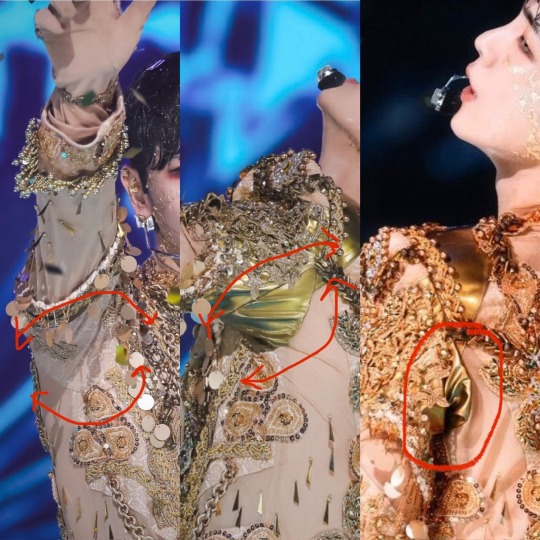
Gussets out of different fabrics under each underarm. You can see the gold bunch under his arm when it's at his side
It allows the performer to more easily move their arms above their chest and head to help keep the top from riding up. You can see in this photo, though, that it does bunch up a little when his arm is down, because of the extra fabric. It has to go somewhere when it’s not taut.
With this particular top, it’s interesting to note that, due to the asymmetrical decoration of his arms, one gusset is the gold stretch fabric and the other is the jacquard. That means that, either both fabrics have the exact same stretch, or his arms may be SLIGHTLY more limited on one side than the other. That’s fun! I really geeked out about this observation.
Often with jackets for dancers, they’ll have what are called “commodity pleats” around the center back shoulder area. They’re a sort of sneaky hidden accordion-like bit of fabric that stretches out during movement that may otherwise split the back open. Taemin uses them a LOT. But, since this top is so boxy, Key doesn’t need them in this instance. He already had the room he needed without any other accommodations.

They put commodity pleats in the back of most of Taemin's closer fitting jackets. I wish they'd make them the same color as his jackets, though!
With Key’s trousers, we’ve already established that they’re made of a fabric with a decent amount of stretch. But since I can’t find many good photos of his bottom half, I’m unsure about if he also has “crotch gussets.”
By this point, I’m kind of notorious as being the “crotch gusset person.”
The following posts explain them in much more detail, but basically, they’re long triangular wedges that start in the trouser crotch and taper down to nothing in the inseam. These are often put in trousers of dancers when people need a better range of movement.
I wrote about this in detail regarding Taemin’s pleather pants he wore in his Metamorph concert, as well as all of SHINee in the Your Number dance video. You can find my posts on the subject here:(Metamorph) (Your Number)
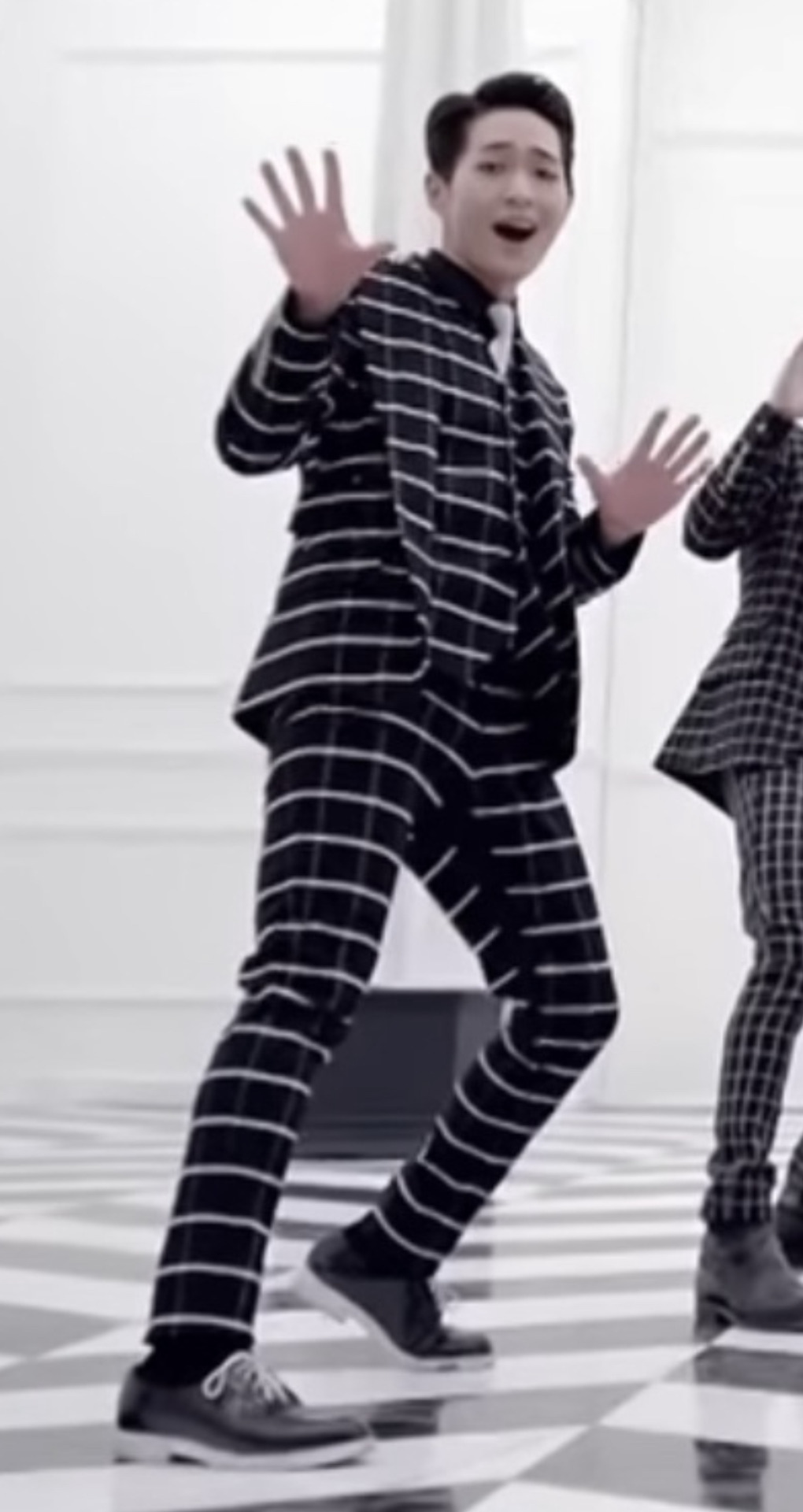
Jinki rocking a black crotch gusset in SHINee's "Your Number" Performance Video (Black Version)
Gussets allow for extra room and movement when one is trying to do extreme leg movements like squatting. Unfortunately, I don’t have many good photos of his inseam. There’s so much going on with appliqués and piecing of mesh vs jacquard, it’s hard to tell. Part of the front half of his trousers is flesh mesh, swirling around them. The other parts are the jacquard, whereas the back is all jacquard.
I saw one photo which made me begin to wonder if the inseam is a little further forward than it could be, though. That could mean there IS a gusset. I’m really not sure...I don't have official visual confirmation, but now you know more about crotch gussets either way. You’re welcome.

That seam line is up a bit more forward than usual. It really has me wondering, because that would happen if there was a gusset installed. Hmmmm.
Okay. Zipper education time. I apologize in advance. Things get spicy but I tried to tamp it down. The center back (abbreviated as “CB” in the industry) of the top has an exposed zipper. This means exactly what it sounds like: it’s exposed. You look at it, and it looks like there’s a zipper right there. It’s not hidden. Sometimes it’s a perfect match, and sometimes it’s “featured.” Exposed zippers actually become a trend every once in a while in everyday fashion.
I thought it was extremely interesting that, on this elaborate costume, they chose to use a zipper with metallic teeth on white “tape.” (The fabric on the sides of the teeth.) It was a huge disappointment for me, actually. I would have loved to have seen the zipper more carefully hidden like his fly was.
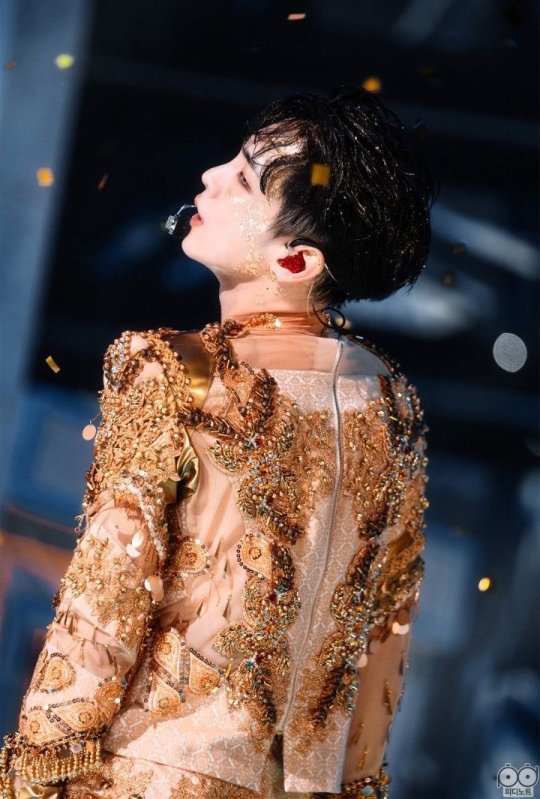
Hello, zipper. I see you loud and clear!
I have to comment a bit on what I view as the one flaw in this otherwise perfect costume. I will preface this by saying that I was not in the fitting room where this was conceived, and I don’t know about any extenuating circumstances and the reasoning behind this decision. But there a few things that I would have done differently regarding the zipper and back collar of this top if were to have made it.
But first: some zipper education. Besides exposed, there are center lapped, as well as regular lapped zippers. With the center lap, it’s like the fabric covers your zipper but you can pull the zipper down through it. Your hoodie probably has one. The regular lap zipper is more like your trouser fly in that there is one flap of fabric that covers the whole zipper, hiding it.

Top: Exposed. (Though it has a matching zipper and zipper tape.) Bottom Left: Center Lapped. Right: Regular Lapped.
Either of those types could have been used to make the zipper more discreet. I personally would have chosen to use a regular lapped zipper, which is less likely to get snagged than a center lapped zipper.
People have defended the exposed zipper by asking if it’s because it’s less likely to get caught. I very much get this argument, and, technically it’s right.
But, in my extensive experience, I don’t think I can recall a case of an exposed zipper in the back of a costume, quick change or no. It’s unattractive. (Not to mention a dead giveaway in a period garment!)
If it’s sewn well and tested, with the correct size lap and no loose fabric, it will work just fine. There should be a hook and eye at the top to make sure that it stays secure while dancing.
Part of being a good dresser is being methodical and purposeful, not frantically zipping something up in a way that is more prone to snagging. They keep their cool, perhaps taking a couple more seconds but ensuring that they pull it up smoothly. They use their fingers to block the overlap as they guide the zipper up.
(Random side note: I met a dresser once who preferred zippers be installed upside down for their quick changes. Hey, whatever works best for them! I wonder how they discovered that…)
I will also note that, as far as I’m aware, the only times he’s worn this costume, he didn’t need to get in or out of it quickly. I know that he wore it in the MV, the Inkigayo performance, and the photoshoot. He also performed at SM Town Tokyo 2022, though he had 11 songs during which to change between Bad Love and this. He never wore this look at his G.O.A.T. in the Keyland concert. Oh, and the collab with the Jinro frog. I’ll talk about that later.
So ultimately, all of the zipper quick change talk is for nothing. There COULD have been a chance that this was going to be worn during his concert, I suppose. But if not, in the end, I can find no reason that there needed to be an exposed zipper other than: they wanted it that way.
Sorry for that rant. I know that it was intense. I just…wish it were pretty. That’s all. I know it wouldn’t have bothered most people, but I personally think that the costume deserved better!
Well then. They arranged the symmetrical beaded appliqué motifs so they didn’t interfere with the center back line, so it wasn’t an issue being all chonky around the zipper.
Unfortunately, since the zipper was built into the neck with just the “stretch mesh,” it moves very differently than the rest of the top. It has a substantially weaker structural makeup and it can’t support itself the same, so it stretched at a different rate than the zipper on the solid fabric on the bottom. It kind of “bubbled” when he moved and it rode up.
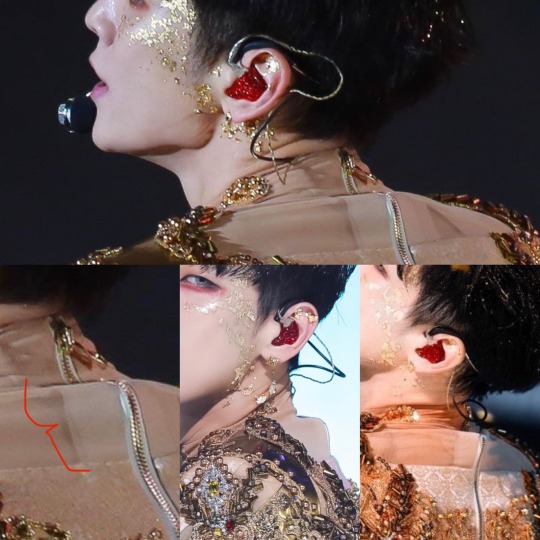
Showing the neck bubbling, and, on the bottom left photo, you can see that there is some sheer stabilizer to ensure that the zipper doesn't just tear out of the sheer net.
It couldn’t have been helped unless that whole back neck area had been backed with the solid nude base fabric. That’s what I would have done, personally. But using the stabilizer helped a bit. Without it, it may have not lasted a performance.
I don’t know why they did it that way, but the result was rather disappointing to me, especially considering the care that was taken with the rest of the garment.
Okay. End rant. The rest of the costume is EXQUISITE.
One more thing to note is that the zipper terminates about 4” above the top’s bottom hem. It is right around where his waist is. It was built that way to ensure that he was able to move his legs and hips comfortably without getting hung up anywhere.
His knee high boots were covered with the same peach jacquard as his top, as well as utilizing the gold fabric to serve as ornamental buckled straps.
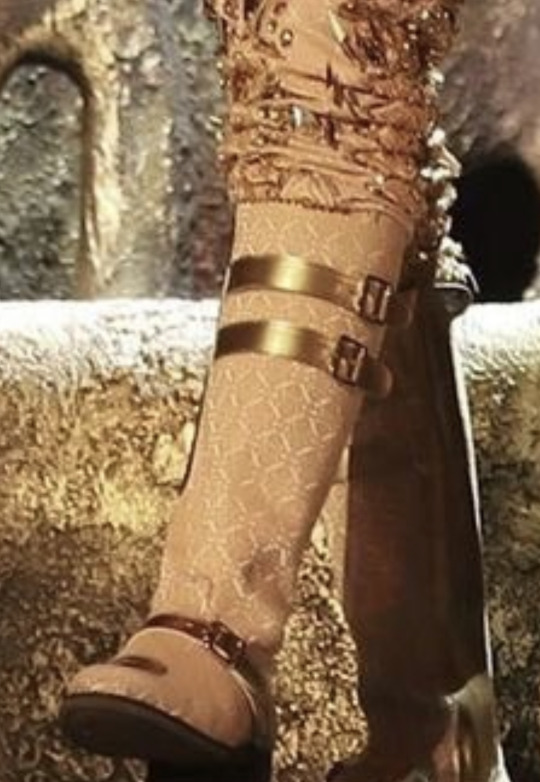
The stretch element of the jacquard is further showcased by the fact that it pulls over the boot toe smoothly, with little issue. A completely stable fabric wouldn’t be able to do that.
Now for the ornamentation. Oooooh boy. There are around twenty types of various adornments on this costume, and I thought I’d highlight some of them.
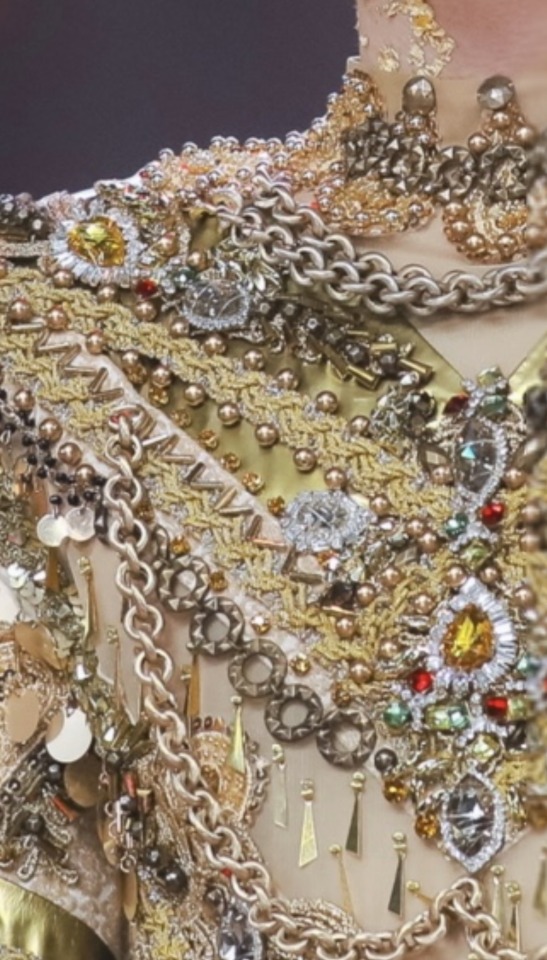
I can spy about 15 different types of ornamentation here alone.
Beaded appliques at the neckline
Heavy chains
Rhinestone appliques and/or individual rhinestone pieces
Bugle bead chevrons
Gold round beads
Yellow individual small rhinestones
Grey beads in between bugle beads
Gold and silver flat braid trim
Gold stretch fabric
Round flat decorative chain
Hanging paillettes
Dark seed beads with some of the paillettes
Gold dangling lil dudes
A sequined applique peeking out from behind a chain
Utilizing the main fabric as a chevon stabilizer as a design detail
About paillettes: these might actually be my favorites. They’re like “floppy sequins” that only have one hole at an edge. They’re made of a very lightweight plastic, so they’re virtually silent. If you wear a dress completely covered in paillettes, you’ll just hear a little rustle. In this case, his were mainly attached via dangly wires as fringe around the upper sleeves. There are a few other random instances throughout the garment where they’re stitched on individually. You can read more about paillettes in my post here.
Appliqués: There are at least three different types of appliqués in this costume:
Beaded
Lace
Sequined
Rhinestone
Appliqués are premade decorative pieces. It looks like someone hand beaded everything on the costume, but they were able to take a shortcut by using these. So no, contrary to what you might believe, there wasn't someone laboriously hand beading every single thing on to this costume.
It still takes FOREVER to invisibly stitch each motif on to the costume as well as, in this case, sometimes layer upon layer. A lot of them are attached to a net base, and in closeups, I saw how they trimmed the net away closely around the motifs.
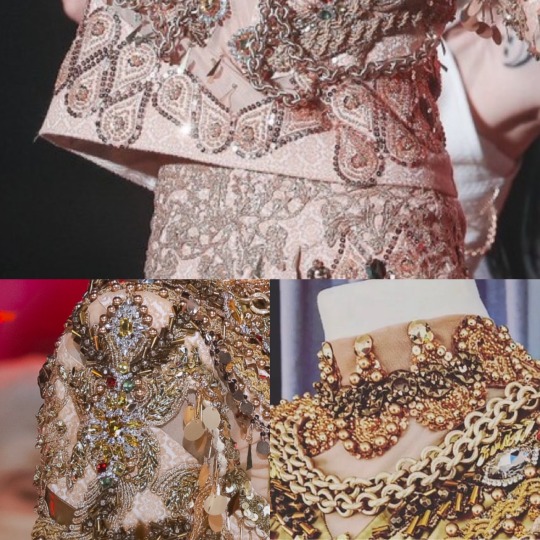
On the top, we have the gold paisley sequined appliques. On his trousers, you can see the low profile lurex embroidered lace appliques. Bottom left, you can see the beaded and rhinestone applique. And on the right, beaded appliques. You can see that they're over flesh mesh so, when it's on Key, it just looks like he has a beaded collar.
The sequined, beaded paisley motifs are the most prominent and plentiful form of appliqués, focusing around the top’s cuffs and lower edge. They’re also heavily featured spiraling around the trousers. There are even some appliqués stitched across the seams of the trousers and top.
There are some huge, gorgeous bead and rhinestone appliqués, like this one on his right bicep that you can see in the photo above.
There’s also the Lurex lace (metallic threaded) embroidered appliqués that concentrate mostly on his trousers' waist and hips. It’s low profile without any bits that might snag the top while moving. They added a few jewels to it further down once it was no longer posing any danger to snags. There are also a few flat appliqués on his rear, so as to not make sitting uncomfortable but still be adorned.
Beads and gemstones: There are also individual beads and jewels both sewn and what appears to be discreetly glued on as accents. A popular adhesive we use for that sort of application is called E6000. It bonds pretty much everything from plastic, leather, metal, rubber, and wood. It’s like a slower acting super glue, but is more flexible.
You definitely need to use this in a ventilated area or, ideally, with a respirator. The fumes are no joke! There are little chevrons made out of long tubular metallic bugle beads that were probably glued instead of stitched on. There are also round bronze beads and gold rhinestones glued to the edges of the metallic fabric.
There are little dangling gold dudes, though I don’t know what they’re officially called. There are individual sew on rhinestones. There are circular decorative flat chains. There is gold beaded fringe at the wrists of the sleeves.
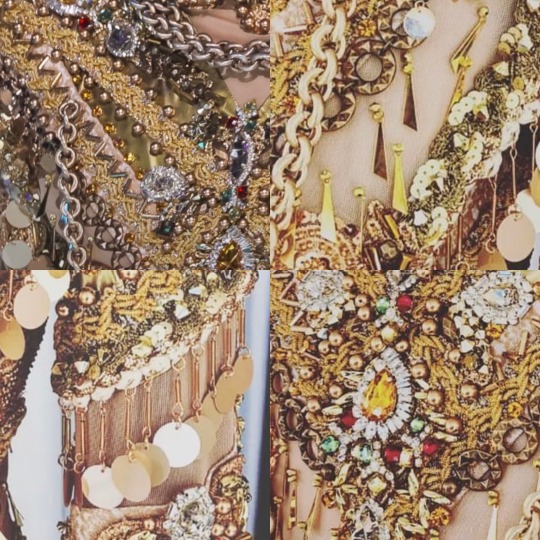
Top left: gold braid, beads and chains are heavily featured. Top right: the dangling gold dudes. I don't know what to call them. Bottom left: Paillettes, hanging on gold wires on the upper sleeve hem. Bottom right: Gemstones highlighting the center of the chest, with a whole organized, beautiful mess of braid, beads, etc.
There’s gold flat “braid” trim that also looks like it has a bit of silver in it to add dimension. It’s basically like a braided ribbon, often in metallic colors. It’s used a lot in military uniforms.
And there are a few other various random beads and trims that show up amongst the circus of adornment.
The layout of the overall design is asymmetrical, with left and right arms and legs that don’t match. However, the front of the top is completely symmetrical (which is extremely impressive) except for a few rampant rhinestones that intentionally deviate a bit. Here’s an abomination I made of the sleeves next to each other to see the asymmetry more clearly.

I THINK (not based on this photo but others that aren't Frankensteined together with different perspectives) that the sleeves are actually different lengths as well.
Something that I should cover is that with garments made out of a stretch fabric, like Key’s trousers in this case, stitching on something non-stretchy (like some appliqués) can be fraught. The appliqué can keep the fabric from stretching as much as it needs to accommodate a body in it, and it might tear off.
Sometimes, we need to stretch the fabric a bit as we sew on the motif so it will look normal when a leg is in it. It may look a bit puckered when it’s not being worn. The good news is that it appears that most of the motifs in this costume are on what is most likely a mesh backing, so they probably didn’t have to deal with that headache here!
Since the motif on the Jacquard fabric is pretty small, as well as the fact that some of the appliqués wrapped across the side seams, “pattern matching” wasn’t a big priority on this. However, it’s always preferable to keep the motifs at the same horizontal height. This is a REALLY small pattern, so it wouldn't matter terribly, plus the fact that it was so covered it can hardly be seen. There WAS a point on the right side seam where the pattern did match, but the fabric slightly torqued on the left so it didn’t. All in all, it wasn’t a big deal whatsoever. If it were a bigger print though, it could have been. I made a thread about pattern matching here. It's a subject I'm pretty passionate about!
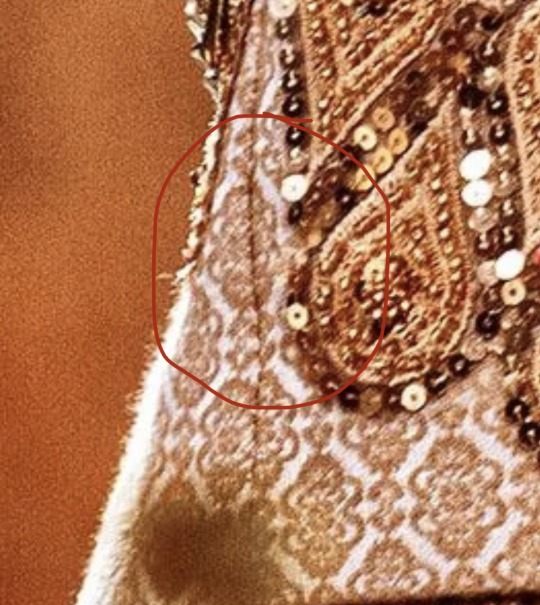
This side seam was cut so that, at a fixed point, the motif was all at the same level horizonatally at there was a part where the motif perfectly matched up to create one complete one. Because there are curves in the seam, it can't do that everywhere.
Now for a bit of a departure: SHINee and its members have done a few collabs over the years, dancing with the frog mascot from Jinro soju. SHINee did one for Don’t Call Me, Taemin did one for Move, and Key did one for Gasoline.
They dressed the frog up like Key, complete with jewels and chains! It was precious. SO GOOD. Watch it now. I also bring this up because that video was the resource I used to figure out where the gold chains on Key’s top were “tacked” (AKA stitched to keep it held down strategically.) It was a nice close-up view. Thanks, Jinro frog!
(Side note: I have made mascots before and it's ironic because they freak me out. I also refurbished a hot dog mascot that had gotten too gross after public appearances over a decade. My life is weird.)
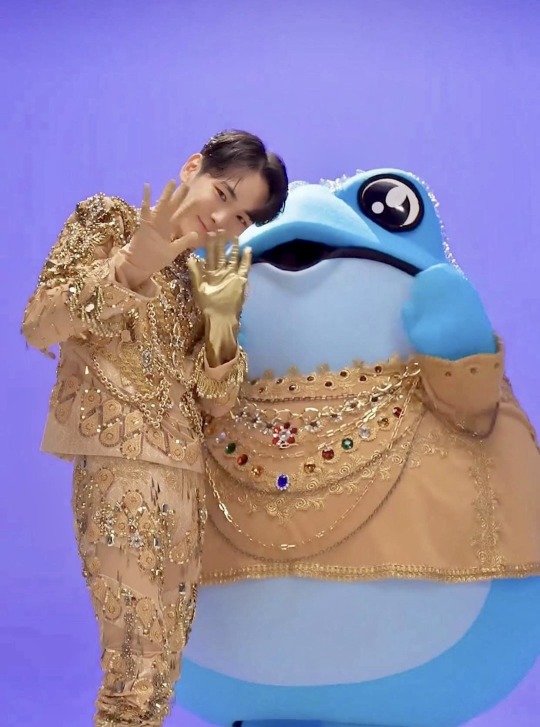
I love how scaled-back but accurate the frog's costume was.
Through the magic of the Jinro frog, I found the answer to the question “where were the chains tacked?” Here. Enough that they still have independent swing and look natural, but frequent enough to keep them from smacking him in the face. Based on the way they move, I think that is metallic coated plastic and not actual metal. Also, for safety's/comfortability's sake! You don't want to be thumped in the chest with every move.
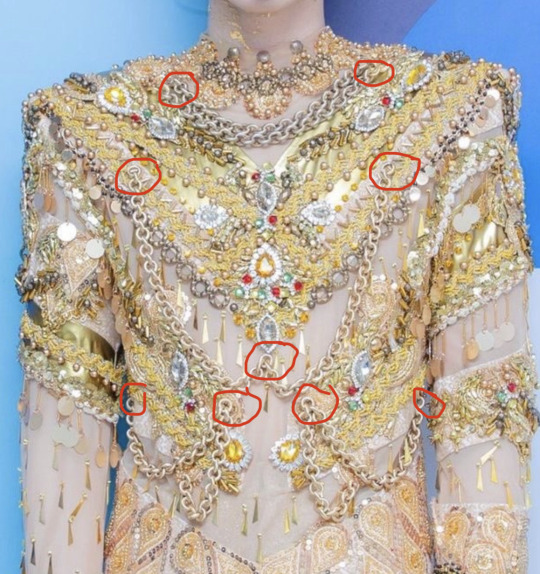
Here's where the chains were tacked
Someone asked me how much they thought this costume weighed. My answer?
I really have no idea…but probably not NEARLY as much as it looks? I'm like 99.9% sure the chains aren't actual metal. I’m not sure if the “jewels” are glass or plastic. The tiiiiiny “seed beads” and "bugle beads" are glass, but there aren’t enough that they would weigh a significant amount. There's a lot of gold braid on there that's very lightweight. A lot of what you see are layered appliqués with sequins and seed beads, which weigh nearly nothing. The dangling paillettes are just a light plastic.
For the garments themselves, as we’ve established, the are a few layers of fabric and mesh, which aren’t very heavy. Because of the “encrusted” nature of the ornamentation, of course, it still weighs a bit more than just a regular top, and is probably kind of rigid on the front. However, it’s not like he’s dancing around in chainmail.
Lastly, there are his gloves. His left one is made out of that heavy gold stretch fabric that was incorporated into the rest of his costume, and his right was also made out of a flesh mesh. From the way it behaves in this photo, it appears to be a much heavier mesh than the top and trousers.

The right glove has thicker mesh that almost appears to have a natural fiber content that is getting snagged. It doesn't completely conform to the skin like a tight flesh mesh would.
The gloves are heavily ornamented with appliqués and beads. I’m going to guess that these were actually custom made for him, which is a big deal. I know very little about glove making, except it involves a TON of pieces to be done right. Gussets in between the fingers to make them slim and elegant and such. No Mickey Mouse hands here.
Stitching the ornamentation on to gloves is pretty difficult work. You either need a hand form and a curved needle or a very brave stitcher who uses their own hand as a form (palm up.) I haven’t done that for gloves, specifically, but I have been a “sacrificial hand” for other situations. I’m so calloused in most places, I don’t really feel much anymore!
There’s one more aspect to this costume that was seen in the intro for his Gasoline Inkigayo performance: the cloak. He didn’t wear it for very long, but it appears to button across his chest to the other shoulder with snaps underneath. The snaps keep the underlap from peeking out from…under the lap.
It looks like they might have had a wardrobe emergency here, because you can see that two of the three snaps were hastily stitched on with red thread. The ornamentation is asymmetrical, mostly focused on his right side. On his left shoulder, there is a decorative beaded “epaulette.” Those are the ornamental shoulder pieces you often see on military dress uniforms.
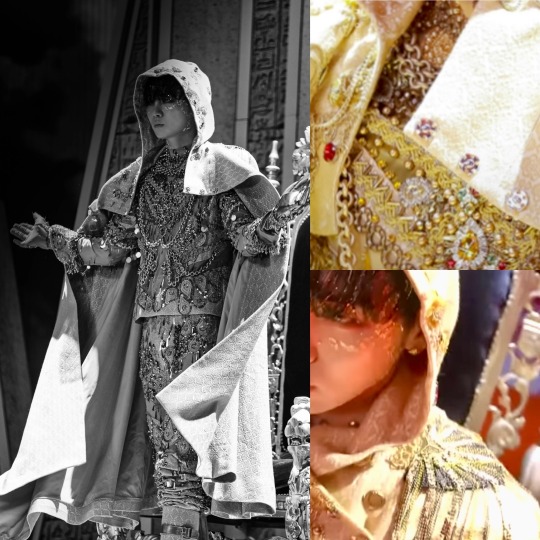
Left: The full cloak. You can see the facing on the inside edges, made of the same fabric as the outside. I'll write about that in a bit, and I'll show you a closer view later. Top right: The red thread holding on the upper snaps. Bottom right: Metallic epaulette.
It’s hooded and made out of the same jacquard fabric as the rest of his costume, and it has a satin lining the same color as the “fashion fabric.” It appears to be about calf length. One of the photos I found actually has a shot that shows the facing, the lining, and how the hem is done. Of course, I nerded out. It’s “self faced,” which means that there’s the same fabric that’s on the outside making up the “facing.” The facing is the first ten inches or so of the inside edge of the cloak. It makes a pretty transition from the outside to the inside, without a harsh switch to lining.
Then, there’s the hem.
While attached at the top, the hem of the lining and the outer fashion fabrics are allowed to “hang out” separately while on a dress form. Because fabrics stretch out at different rates (and it also changes by the direction they’re cut from the fabric, but that’s a whole different lesson…) it’s ideal for something like this to hang on a dress form and do its thing for a day or so.
In an ideal world, you’d have a fitting with your performer and you would mark a “level line” on them while they’re wearing the cloak (and also the shoes they will be wearing. Different shoes can change a lot!)
There are several different ways you can mark a hem. You can safety pin it up the way you want it, using a ruler measuring up from the floor to keep it even. But this can be awkward and clunky.
Or you can safety pin a “level line” and say that it’s, for instance, 18” off the ground, and you’d like the hem to be 16” off the ground. You’d draw a new hemline 2” down from the pins. It's the easiest way to know what's level and then decide exactly what you want to do later.
OR you can use what I call “the poofer” which is a little measuring stick on a tripod with chalk and a rubber squeezy ball that poofs chalk into a line at a set height, instead of dealing with pins. But sometimes the chalk doesn’t like to brush away, so that’s a bit of a risk in exchange for convenience.
First, let’s talk about hemming the outside cloak fabric. Because it may have stretched out unevenly, you may have wildly different hems lengths now that they’ve been “leveled.” Let’s say we’ll leave 6” of “hem allowance” to fold up into the garment so it can be lengthened later if we need to. You’ll trim the rest of it away. I can’t tell you how many times I’ve altered hem lengths on cloaks over the years! I'm always grateful to have extra.
You may want to finish the hem with a “serger” or “overlock” machine, which is the sewing machine that uses 3-4 threads to sew things, often stretch, together and kind of seals off the edges. It’s probably what stitches together the side seams of your t-shirt or hoodie or lounge pants or basically anything stretchy. It’s used to keep hems and the edges of fabrics inside garments from fraying. Sometimes people don’t do it, especially since it's inside, but it’s nice if you’re planning on altering it or if the fabric is really prone to fraying.
The cloak fabric is then thoroughly pinned and hand stitched up. There are many different sneaky stitches which grab a few threads at a time from the front of the fabric and are virtually invisible. Everyone has their favorites. My personal favorite is the “vertical hemming stitch” or “vertical blind hem.” I like it because it holds the inner hem and the outside of the cloak more tightly together than a lot of other styles. The “cross stitch” which is called the “blind catch stitch” here in this diagram is one of the most popular methods. However, I feel it can be a bit too loose some times and is more likely to be caught on something. The one downside of the vertical blind hem is that, if you pull it too tight, it’s more likely to show from the outside. It takes a very sensitive hand to get it right. The lining is usually slip-stitched to the cloak hem.

Once you’ve got your level line of your fashion fabric, it goes back on the dress form. I’m…not entirely sure I’ll do a good job explaining this because I work best with showing things with points and grunts. My apologies.
You mark the lining to match the level where the hem of the fashion fabric ends. You decide how far up from the bottom of the hem you want the lining to end (in this case, 4”.) So normally, you think you'd fold it up 4", right? Ha! You subtract two inches from that number. This means you’ll be folding up only two inches of lining. But, since we will be stitching it 4” up from the hem, that means there’s a floppy extra two inches. (Cue Advice.) What’s that for? Now I have to tell you about “jumps.”
Jumps are a sneaky trick. This method is used in suit coat hems and sleeve linings as well. Basically, they’re a way to give a little bit of wiggle room with the length of the lining to hem interaction.
After the fashion fabric is hemmed, you hand stitch the lining 4” up from the hem. You have two extra inches of lining. One extra inch of lining is pressed down so there’s an extra inch of “underlap". This photo (top right) showed me that they had done this to Key’s cloak. You can see it stretched out with the pressed line on the left, and it is folded over on the right.
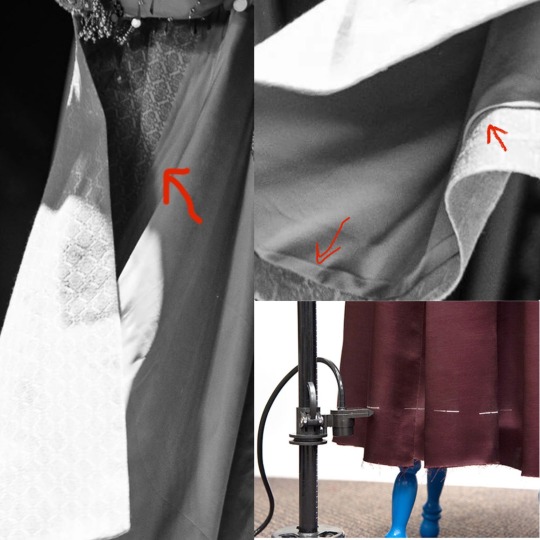
Left: The "self fabric facing" at the center front inside of the cloak. Top right: The cloak hem showing the underside of the "jump" (left) and it down in its "resting" position (right). Bottom right: the "poofer." They're marking a level line.
If you want to get even MORE granular, that is considered a “soft press”, which means that the iron steams and very lightly rests on the fabric. A “hard press” is what it sounds like. Squish that lil dude and steam the heck out of it. That line is never gonna come out.
Okay. Enough of that. I can’t believe myself.
I could literally discuss this costume inch by inch, but I think I’ve covered it enough that you can peruse it yourself if you’d like and kind of know what you’re looking at.
I deeply admire and respect the, perhaps, 100+ hours of craftspersonship that it took to make this stunning costume. Don’t even ask me what it cost to make!
Do check out the Instagram of @denicheur.official where you can see other costumes they’ve worked on for groups like IVE, Enhypen, Stray Kids and more. They’ve got an amazing portfolio to drool over.
I hope you’ve gained an even greater appreciation for this gorgeous look, and the knowledge you’ve gained here can go forward with you as you enjoy future costumes! And thanks so much for sticking with me. I hope it was worth it!
#Shinee key#Key shinee#kpop#kpop costume#kpop costumes#Key#shinee#costume design#costume construction#costumes#gold costume#costume analysis#fashion analysis
63 notes
·
View notes
Text
Danai - Fashion Queen


Black Panther star Danai Gurira was seen at the film’s European premiere wearing a black figure-hugging gown featuring a phoenix crafted with 3 000 Swarovski crystals and 2 000 sequins. A further 380 hand-cut mother-of-pearl ornaments elevated her dress to couture artistry. Each opalescent shell was hand-carved, lacquered, drilled with a fine hole, and sewn into place individually to overlap like feathers. Vogue


[After wearing his gowns to the premiere] the atelier was quickly inundated with calls. Vogue


Jean-Louis Sabaji SS18
11 notes
·
View notes
Text

From Maison Margiela Insta
A pale grey thistle-washed boiled cashmere cardigan brushed to achieve a swan’s-down texture worn in a déshabillé gesture and draped over a corset made from an eighteenth century antique brocade fabric rewoven in jacquard silver threads and an ‘exfoliage’ skirt hand-wired in a ‘filigrading’ of silver metal formations of lace, flowers, leaves and sprigs interlinked with silver chain and floral motifs cut from mirror fragments, and bedecked with crystal pendants, pearls and clasped jewellery. Created for Kim Kardashian by John Galliano for Maison Margiela, the haute couture silhouette was inspired by the symbiotic love affair between Elizabeth Taylor and her jewellery. Forged in the memory of gem-encrusted parures, guilloche-graved surfaces, cannetille and claw-set stones, brilliant-cuts and baguettes, and ornamented clasps and silver clips, it is imbued with the seductive spirit of the haute joaillerie of Place Vendôme in the golden age of haute couture. The look further reflects on the notion of ‘unconscious glamour’ (origin: Artisanal Collection Spring-Summer 2017), the evocation of iconography that resonates as glamorous in our collective awareness. A new technique, ‘filigrading’ – a portmanteau of filigree and ‘retrograding’ – evolves, through hand-wired metalwork, the practice of ‘retrograding’ which denotes a dégradé of thread-work, appliqué or encrustation. Over a thousand hours in the making, the hand-embroidered form was crafted to refract the light in the manner of jewellery. The haute couture skirt advances the cutting technique of ‘exfoliage’ through which the top layer of a garment such as a dress is seductively déshabillé-draped over the front of a skirt, essentially exfoliating one garment to create a type of foliage within another.
11 notes
·
View notes
Text
The Wicked Witches of the West (9)
There is only one direct adaptation of the novel-Wicked Witch who gained an autonomy and a fame able to rival with the MGM-Witch. I am speaking of course of the Wicked Witch of The Wiz: Evillene of the West.
Evillene gained life in the original 70s Detroit/Broadway musical "The Wiz", played by Mabel King. Already you had a VERY iconic outfit - a crazy hairdo like the Good Witches, but all dressed in black with violent red highlights (as opposed to the soft blue or pastel pink of the Good Witches) ; a large body highlighted by the equally large dress (which is quite interesting as the Wicked Witch of the West is VERY rarely depicted as fat), and of course the iconic eyes-on-the-chest symbolizing Evillene's constant surveillance over her enslaved subjects.




Later, this enormous stage success was adapted as a... divisive though cult movie let's say, 1978's The Wiz in which Mabel King took back her role for the witch Evillene, but with quite a stylistic change. Instead of black, her dominant color became red. The aggressive, hostile makeup was replaced with caricatural prosthetic echoing the ones worn by Hamilton to deform her face as the Wicked Witch. The dress became a clunky accumulation and an overload of ornaments, reflecting Evillene's nature as a massively wealthy hoarder mixing riches with junk - see the caricatural headwear made of several crowns piled up together in a helmet. The choice of red was notably to clash with the outfit of the Good Witches, who both wore blue (blue and red being the two "dominant" colors on each side of the green of the Wizard in the color spectrum).



Another important actress who embodied Evillene in her "early days" is Ella Mitchell - she first played the role after Mabel King, in the 1976 version of the show, and then took back the role for the 1984 and 1992 versions of the musical. Due to crossing over the decades, her Evillene went through various costumes. From one mimicking Mabel King's one in the 70s, to her 80s outfit which had more of a "cute evil" thing going on - she still was an evil witch dressed in black and purple but was ornated with butterflies, snowflake-shaped flowers and other leafy, "natural" jewels - all the way to the 90s one where she had a more "stereotypical" children fiction witch look, with an abundance of bats, skulls, spiderwebs and other "Halloween-y" symbols on her costume.


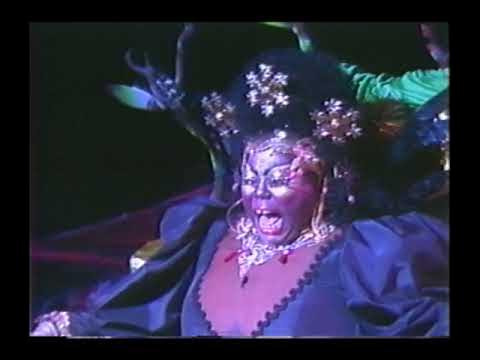
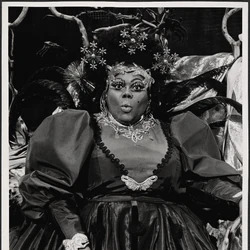
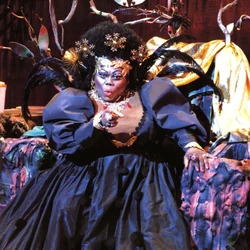
I unfortunately cannot list all of the actresses of Evillene and productions of "The Wiz", because there's a very rich history in there - so I'll limit myself to two more examples.
On one side Mary J. Blige's portrayal of Evillene in "The Wiz Live!", which is another example of - yes I am still going on about it - the glamorization of the Wicked Witch of the West, as Evillene becomes a statuesque, dominating beauty and her dark, bizarre dress looks more like futuristic evil haute-couture.



On the other, Melody A. Betts in the recent 2024 production of "The Wiz". In this production all of the witches are dressed in various shades of yellow, but as opposed to the light and gold yellow of the Good Witches, Evillene's shades are darker yellow and a lot of oranges, reflecting a strong fire motif for her character. You also note a shift in terms of style, as the witch has a more "proper upper-class lady caricature" vibe going on (the collar ornaments evoking a pearl necklace, the gloves, the hairdo).
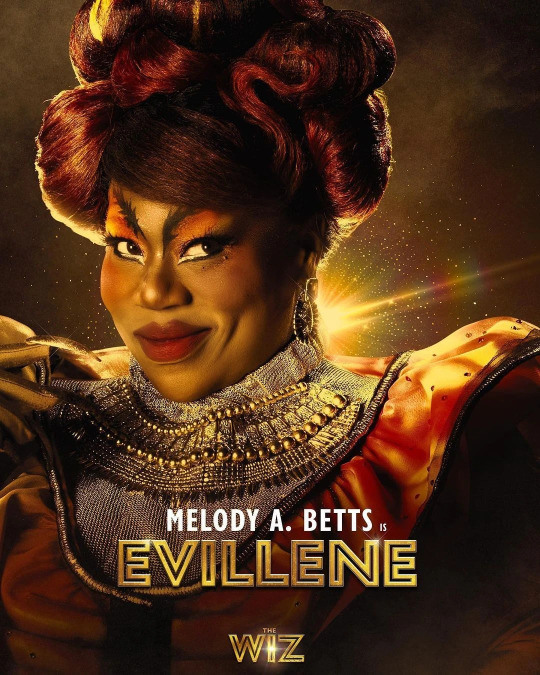

#the wicked witches of the west#wicked witch of the west#evillene#the wiz#the wicked witch of the west
6 notes
·
View notes
Text
i'm sorry but my health psychology class is absolutely wild
so this week's topic is sexual health and sex education. first half of the tutorial was reviewing actual sex education programmes from various schools. one of these was condom couture. that is, being as creative as possible with condoms to make clothes, ornaments, etc.
turns out a bunch of people aged between 18 and 30something are as excitable as 12-year-olds, and as such, we had great fun. someone made a spider. most of us were blowing them up and making balloons, earrings, and the like. one condom balloon deflated and spiralled upward, cartoon-style, till it hit the roof.
during the break, we had to work out just how to get rid of these condom creations, and as such, there were about four of us in the women's bathroom, one of whom was holding a matryoshka condom: that is, a normal, rolled-out one inside a blown-up one inside a huge, larger blown-up one. this was decorated with pipe cleaners, sparkly balls, and googly eyes. it was fairly large. i couldn't see a bin in the bathroom, so was wondering what to do, when i realised there were sanitary disposal units.
'pass it to me,' i said, idiotically, to the bearer of the matryoshka condom.
she did. and, despite her and two other people protesting loudly, i tried, blithely, to stick it in the sanitary bin. it went in, but would not go down. if you lift the lid back up, it's still there. nothing will get into that bin and nothing will get out. one googly eye stares, vacantly, at whoever dares lift the bin lid. next person to go into there is gonna have the jumpscare of their life. i couldn't be more proud

behold the abomination itself
#best class ever.#this is a university subject for the record#a damn good subject#but oh my god best class ever
8 notes
·
View notes
Text
My Professional Journey…
Throughout my 20-years journey, I've learned to rely on my own strengths and talents. I have passout from NIFT Kolkata in 2002-2004 batch. BFA & MFA from Prachin Kala Kendra Chandigarh, despite having a good network of friends and fashion professionals, I've found that genuine support and opportunities have come from unexpected sources.
I've navigated the fashion industry for over two decades, facing numerous challenges and setbacks along the way. Without the support of influential connections or referrals, I've relied solely on my talent, dedication, and resilience to propel my career forward.
The absence of a strong professional network or mentors meant that I had to forge my own path, often through trial and error. Despite these obstacles, I remained committed to my passion for fashion design. I recognised that my creative talent was a valuable asset, one that I was determined to hone and showcase.
Throughout my journey, I've encountered various opportunities that have helped me grow both personally & professionally. These experiences have taught me the importance of adaptability, hard work, & perseverance in overcoming adversity.
One of the most significant lessons I've learned is the value of self-reliance and motivation. Without external support or encouragement, I've had to develop a strong sense of self-discipline and drive to push myself forward.
My struggles have also taught me the importance of continuous learning & skill development. Recognizing that the fashion industry is constantly evolving, I've made a conscious effort to stay up-to-date with the latest trends, AI Tools, technologies, design softwares & new garments construction techniques.
This commitment to self-improvement has enabled me to stay competitive in the industry, even in the absence of strong professional connections. My determination to succeed has ultimately led to opportunities that have helped me grow both creatively and professionally.
In reflection, I realize that my struggles have been a catalyst for growth, forcing me to develop a strong work ethic, resilience, and resourcefulness. While the journey has been challenging, I remain committed to my passion for fashion design, driven by the belief that my talents & technical skills will ultimately lead me to achieve.
I have been highly acclaimed artist & fashion designer with a rich experience worked alongside legendary designers like Ritukumar, Rohit Bal, and Raghvendra Rathore, With a specialization in Indian ethnic outfits & Indo-western outfits. My deep understanding of Indian prints and embroidery aesthetics and a keen eye for detail.
I have participated of painting exhibition in Lalitkala academy new delhi from 14th to 20th April 2024. And many other art and fashion exhibitions across India and abroad.
Have been won numerous awards for my outstanding contributions to the art & fashion industry. My designs are a testament to my creativity, passion, and dedication to preserving India's cultural heritage.
My passion and dedication to designing have been unwavering, even in the face of challenges and periods of unemployment. I've remained committed to my creative profile, recognizing that my artistic talent is a valuable asset passed down from my parents.
One of my most cherished achievements is earning the recognition and respect of the renowned 80-year-old legend fashion designer, Ritu Kumar. Our encounter four years prior left a lasting impression, and I'm humbled that she remembers me and my name. Legendary RK, RB and RR have been renowned fashion designers of India and my fashion Guru I have learnt a lot about traditional prints design, surface ornamentation, Indian ethnic fashion & wedding outfits.
For me, success isn't solely defined by financial gain. Instead, I prioritize honesty, hard work, and transparency in all aspects of my life. I believe that these values, combined with my passion for designing, will ultimately lead my couture brand to achieve my goals.
Sincerely
Madhusudan Kumar Lal
Couture Fashion Designer (HOD)
New Delhi, India

#fashion#haute couture#style#vogue#fashion show#fdci#creature#creative design#creative process#creative arts#indianethnicwear#india#india tourism#indianheritage
2 notes
·
View notes
Text
Christmas Party Outfit Themes
Here are some fun and festive Christmas party outfit themes to consider:
Ugly Christmas Sweater Extravaganza:
Embrace the tradition of donning the most outrageous, tacky, and humorous Christmas sweaters you can find.
Santa's Workshop Elves:
Dress up as Santa's little helpers with elf hats, striped stockings, and pointy shoes. Go for vibrant greens and reds to capture the playful spirit.
Winter Wonderland White Party:
Opt for an elegant and chic look with all-white outfits, incorporating faux fur, sequins, and sparkles to create a winter wonderland ambiance.
Festive Pajama Jam:
Keep it cozy and casual by inviting guests to wear their favorite Christmas-themed pajamas. It's perfect for a laid-back and comfortable gathering.
Candy Cane Stripes and Peppermint Patterns:
Go for outfits featuring the iconic red and white stripes of candy canes or peppermint patterns. It's a sweet and visually striking theme.
Christmas Movie Characters:
Come dressed as your favorite characters from classic Christmas movies. Whether it's Buddy the Elf, the Grinch, or characters from holiday classics, it adds a playful touch.
Festive Formalwear:
Elevate the celebration with a formal dress code featuring rich colors like red, green, and gold. Think glamour and sophistication for a classy Christmas affair.
Nutcracker Ballet Elegance:
Channel the enchanting world of the Nutcracker ballet with outfits inspired by ballerinas, toy soldiers, and the magical Land of Sweets.
Christmas in the Tropics:
If you're celebrating in a warmer climate, consider a tropical Christmas theme with Hawaiian shirts, floral prints, and Santa hats.
DIY Ornament Party:
Challenge guests to create their own Christmas ornaments and incorporate them into their outfits. It adds a crafty and personalized touch to the party.
Gingerbread House Couture:
Draw inspiration from gingerbread houses with brown and white outfits, candy cane accessories, and perhaps even some gingerbread-scented accessories.
Frosty the Snowman:
Embrace the charm of the snowman with white and blue outfits, top hats, and scarves. You can even add snowman accessories for a whimsical touch.
Choose a theme that resonates with your group, and encourage creativity and festive spirit in the outfits. Whatever theme you choose, it's sure to make your Christmas party memorable.
#christmas dress#wedding gown#fashion design#wedding dresses#wedding dress#fashion dress#evening gown#ball gown#fashion gown#christmas#fashion#white dress#dresses#cross dressing#sissy dress#black dress#dress
18 notes
·
View notes
Text
How I Create Original Characters for My Fanfiction (That Readers Seem to Love)
The general consensus for fanfiction is to not like original characters. And honestly, I totally agree! I'm here to for the canonical characters. I'm reading fanfiction because the characters who I love/find interesting/want-more-of already exist.
However...
Sometimes, as a writer, you take the story in a direction where it's veered enough away from canon that you kind of write yourself into a corner. You need a character to do/be something very, very specific. It is essential to your plot. But that specific character doesn't exist in canon. And you can't have a different existing character stand-in for the role either.
That's when I have no choice but to make up original characters.
When I create original characters, I actually take great care not to overuse them. They are, essentially, there to to advance the plot—which always revolves around a canonical main character in my stories—and there for the advancement of plot only.
But what's the point if you don't make your original characters interesting too, right? Just as I love the canonical characters, I want to love my original characters just as much. I put the same amount of love, care, and thought into all of my characters, canonical or original.
I fit them into the world as if they had always been there. Them being there, interacting with the canon characters, existing in the world they're in, has to make sense, has to feel natural.
It sounds easy, but it's actually a delicate balance. And the whole time, I need to remember first and foremost that the character is only there for a specific reason. They're only supposed to be a supporting/minor character. (Because otherwise, fanfiction readers would dislike them.)
I could expand upon the theory more, but the title of this post is "HOW I Create Original Characters for My Fanfiction (That Readers Seem to Love)."
So, I think the best way to explain would actually be to take you through my step-by-step process for creating an original character. Here we go!
My best example of an original character (so far):
In my current long-fic (a Catwoman/Batman story called In Another Life), my original character is named Grace Crowne. Now, if you're a big Batman fan, you'll know that the Crowne family exists in-universe but not very much is known about them. Well, that made them perfect for me to base my character on, then.
Here's where I started: I needed a character in my fanfiction to give Selina Kyle a job. Specifically, a job that would allow her to interact with the wealthy elite while also plausibly allowing her to be Catwoman. That was the utility of this character.
Without getting into too many of the tiny details, a rich socialite character who's lax on working hours was the perfect fit for what I needed. But I also needed that rich socialite to not be in the same social circles as Bruce Wayne (because otherwise, he and Selina would have met already!).
So, I made Grace Crowne a sixty-five-year-old woman in my story—far enough removed from Bruce just by age that it wouldn't be likely that they would be close, and old enough that she has complete agency over her own life to do whatever she pleased (like start a foundation and make Selina the director).
After that, it was just about crafting a believable personality for Grace to have her end up giving this job to Selina:
As part of the Crowne family, Grace is a seasoned, wealthy Gothamite who has lived there all of her life and chooses to stay. There's a certain practical recklessness that comes with that, so I colored her in with little details like Grace carrying a tiny rose-gold pistol in her tiny, ornamental couture clutch purse (studded with actual jewels).
Once I had that, then, it only makes sense that a person who carries a gun around in a couture clutch would be fearless and confident and stylish—would love the spotlight, actually.
That character would have flair (so much flair), so I write her to be as dramatic as a Golden Age Hollywood starlet (which is just as much an act as it is her personality). And underneath her larger-than-life personality, I emphasize how generous and caring and truly wanting to help the people of Gotham (because she has that foundation, remember) she is.
You see, my original character Grace Crowne has her own life and wants and motivations even though she's basically there to be Selina's boss. And she fits in with the established Gotham uppercrust so well, while also being so uniquely herself, that readers don't mind when she appears. (I dare say that the readers of my fanfic may even like her.)
At the very end of all of that, I decided what she looked like. In this case, I based her on the actress Grace Kelly because I had already named her Grace (because of the religious motifs in my story). So, she looks like this in my mind when I write her (just older):
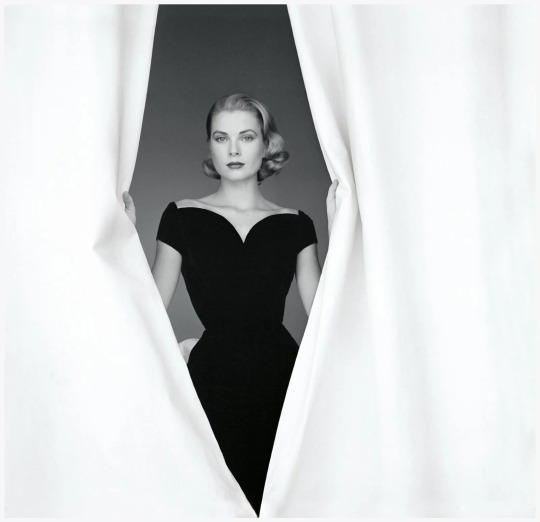
And that's how I create original characters for my fanfiction, and how I created Grace in particular.
But hey, if all you want to do is create original characters and stick them in a canon universe (or you write OOC or self-inserts or Y/Ns or whatever else there is), then more power to you! It's all up to you, fanfiction writer. I'm just writing from a "mainstream" fanfiction perspective (however much fanfiction can be mainstream, I guess).
Still, I hope this post helps you in creating your own original characters. (Plus, I've gotten questions from readers in the past about my original characters, so I thought I would write this out now and just direct them to this post in the future lol.)
(*Special thanks to @daydreamerwonderkid for inspiring this post!)
#dlaugh#fanfiction#fanfic#writing advice#fanfic writing#character creation#writer#writing#writeblr#original character
25 notes
·
View notes
Text
Introduction
Throughout the 19th century the use of, corsets, bonnets, top hats, bustles, and petticoats were highly common. Women were consistently characterized by full skirts that gathered more towards the back of the silhouette giving it a train. However as the era came to an end the aesthetics movement began, introducing more flexible floaty clothes which gained popularity, making it more comfortable and relaxing to move about than in the earlier 19th century.
Queen Victoria
The Victorian era lasted from 1837 to 1901, this was the 63 year reign of Queen Victoria over Great Britain and Ireland. Which was when the British Empire expanded globally increasing Britain's power and wealth. Previously men were the main focus of fashion as (fashion usually follows the royal family, determining the current fashionable garments) the former ruler was William IV meaning he was the main style icon for men. However, with Queen Victoria being on the throne, women's fashion took over. One of the roles women obtained through this time was to display the status and wealth of the husbands while the men withdrew into the background. Throughout her reign, many styles emerged and evolved and Queen Victoria became a style icon of the era.
Crinoline

These were originally a stiff fabric with a weft of horsehair and a wrap of cotton or line thread.
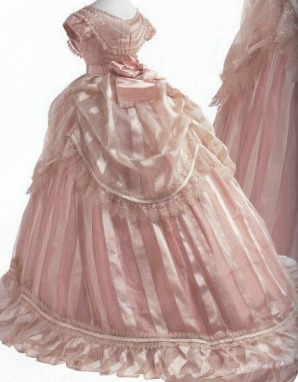
This evening dress from 1866 demonstrates the significant size that can be achieved with the crinoline when using the correct dress.
Bustles
In the 1870s, women's fashion emphasised the back of the skirt, including long trains and elaborate bustles filled with intricate layers of flounces and ruching. Compared to the 1860, the waistline was lower and bodices becoming longer and more fitted, while the skirt had a flat front. Low, square necklines were in fashion and hairstyles were styled high at the back with intricate details, often detailed with ribbons, bands, and ornamental combs. during this period hats were small and often tilted forward over the forehead.
Eastern influences
During the middle of the century, a variety of Japanese goods were introduced to Western Europe. The kimono and other types of fabric influenced many garments.
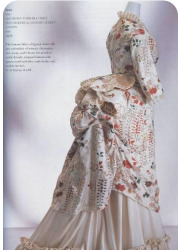
This specific dress with a bustle was re-tailored in London from a Japanese kimono, it was made by hand by Misses Turner.
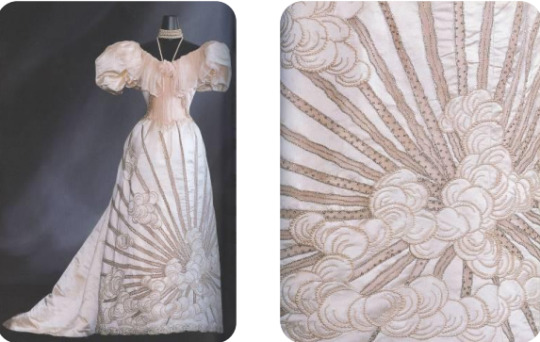
This evening dress was made in 1894, which was all hand embroidered, strongly influence from Japan and there Japanese prints. Fans were also a very popular accessory which can also incorporate Japanese prints, these were also influenced by Japan. By the end of the Victorian period the skirt had start5ed to decrease in size partly due to the development of the princess line gown.
Mourning in the Victorian Period
There were four periods of mourning, each one with its own rules band customs. The first period of mourning or deep mourning lasted one year and one day. The costumes were of two pieces, a bodice and a skirt.
Working class women could make a cotton dress or dye one in black.
Middle class-women could choose among black wool, cotton or silk.
Upper-class women could use the latest trend but always in silk or wool. The main feature of this period was the long black veil that reached to the waist or to the knees.
Women couldn't wear jewellery. They could only leave home to go to church or visiting relatives. If the wife had no income and small children to raise, they were allowed to marry after this period.
Charles Fredrick Worth
Charles Fedrick Worth was an influential English fashion designer, often regarded as the father of Haute Couture. He introduced the concept of the fashion designer as a creative force and established the first couture house, Maison Worth, in Paris 1858. He was known for dressing royalty and aristocrats.
Date of Birth: October 13, 1825
Date of death : March 10, 1895
Age at Death: 69 years old
In the later half of the 1880s the bustle reduced in size and the dresses changed to a more simplistic style. Worth also considered every aspect of a gown.
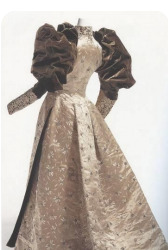
In this this image the skirt has reduced in size again, this is called a funnel shape, a neat, slender shape with a flaring hem. Contrasting with this, around 1890 the shoulders expanded. This dress from 1892 is made from off-white satin and velvet sleeves.
4 notes
·
View notes